Asparagus risotto is a creamy, bright, and delicious recipe for a special dinner with your loved ones.
Making risotto is easy, and with our step-by-step pictures and video, your risotto will be a guaranteed success on your first try.
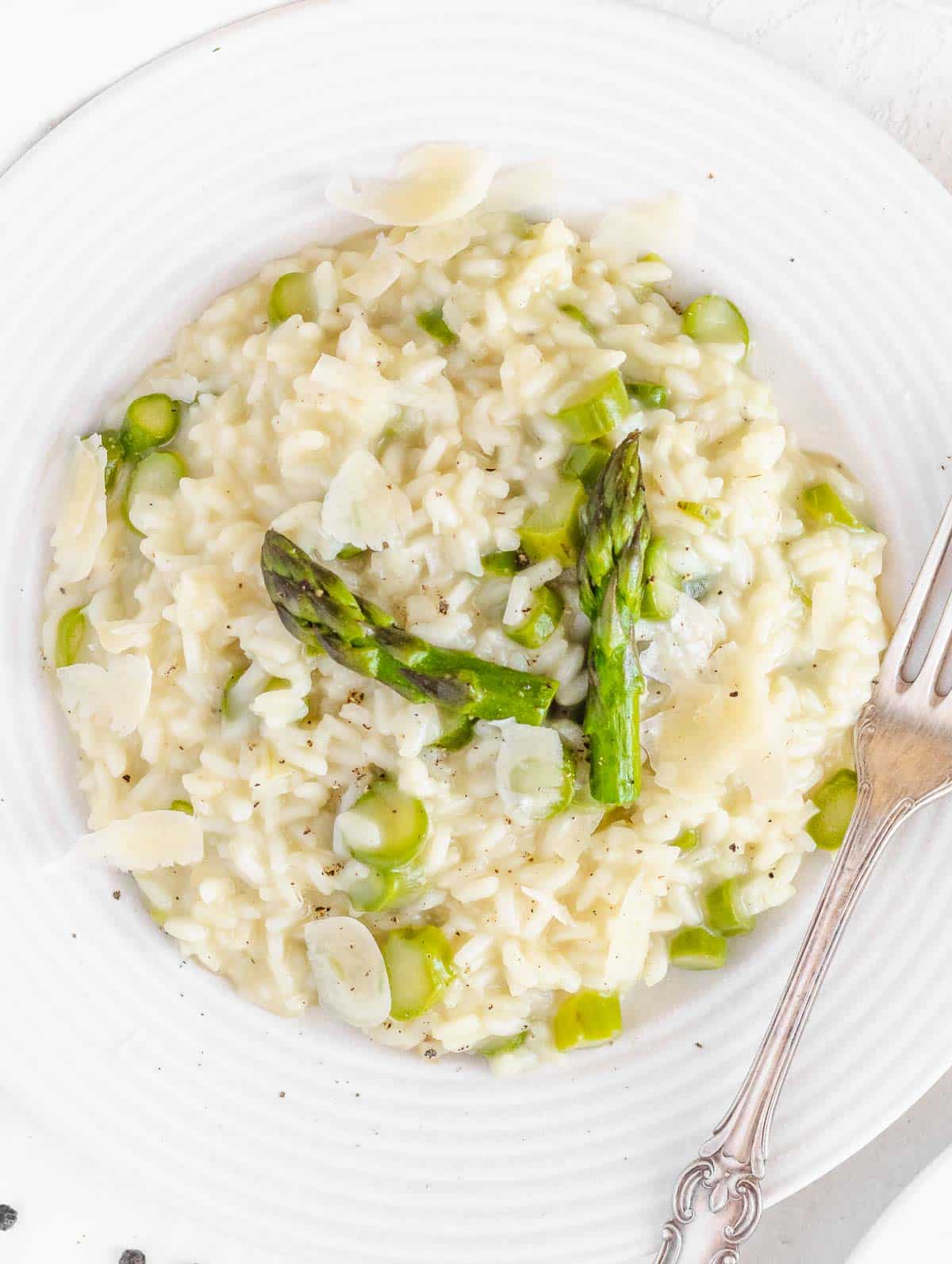
Check out our best Italian recipe collection!
Table of Contents
Asparagus risotto is a comforting Italian dish, perfect for a family dinner or special occasion.
Everyone will love it, kids and adults alike, because it’s tasty, creamy, cheesy, and one of the most comforting meals you’ll ever make.
It’s a wonderful vegetarian recipe that even the staunchest of meat eaters will gobble down and ask for seconds.
And if you have vegan guests over, you can easily make the recipe dairy-free with a few simple modifications.
You’ll need about 45 minutes to make this from start to finish, and if you follow our simple step-by-step instructions, you’ll have no problems, and the dish will turn out delicious!
On a personal note, I’ve been making all kinds of risottos since I was ten years old; it’s one of my favorite recipes because of how comforting it is.
I am happy to share with you all I’ve learned through the years of cooking this wonderful Italian dish.
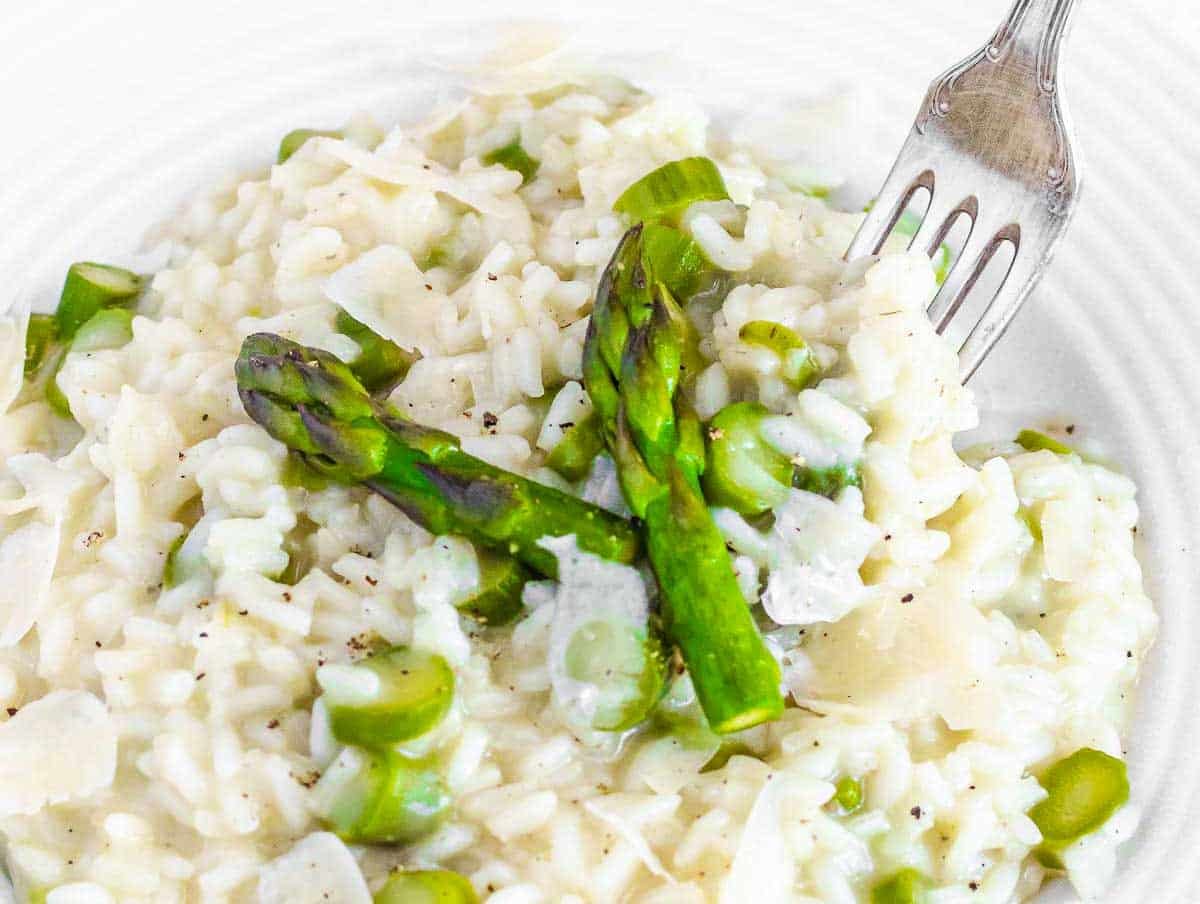
Ingredients
Risotto rice
The best rice for making risotto is risotto rice. It’s a medium to short-grain rice with high starch content. There are several varieties of risotto rice.
Arborio rice, Carnaroli, Vialone Nano, and Roma are the most common.
If you can’t find any of these, go for generic risotto rice.
The main characteristic of risotto rice is that it has a higher starch content that helps make the dish ultra-creamy. Therefore, please do not wash the risotto rice before using it.
Asparagus
If in season, we recommend using fresh asparagus.
Substitute frozen asparagus for fresh ones.
Garlic
We use garlic to sauté the asparagus; they are delicious together.
Olive oil
We recommend a good quality extra virgin olive oil to make a flavor base (soffritto in Italian) that will add taste to the rice. We also use olive oil for cooking the asparagus.
Shallots
Finely chopped and gently fried in the oil make an excellent flavor base for the risotto.
Substitute white or yellow onion for shallots.
White wine
Dry white wine is used to deglaze the pan after the rice has been toasted.
It adds acidity to the risotto, which boosts flavor.
If you prefer not to use wine, you can replace it with vegetable stock.
Vegetable broth
The liquid to cook the rice. You can make it yourself from scratch or use a ready-made one.
What’s important is that you bring it to a simmer in a separate pot or saucepan and keep it hot before adding it to the rice.
Also, if you want to go the extra mile and make the risotto even more flavorful, add the woody ends of the asparagus to the stock to infuse it with the asparagus flavor.
The rule of thumb is to use 4 cups of vegetable stock to cook 1 cup of rice.
You can substitute chicken broth for vegetable stock, although we prefer to keep the recipe vegetarian.
Salt and pepper
We recommend sea salt or kosher salt and freshly ground black pepper.
Don’t add salt at the start because the vegetable broth should already have enough.
We recommend tasting and adjusting for salt when the asparagus risotto recipe is almost ready.
Butter
We recommend unsalted European-style butter.
Substitute vegan butter for regular butter to make the recipe vegan. Alternatively, you can replace the butter with extra virgin olive oil.
Parmesan
For the best risotto, try to use “Parmigiano Reggiano” or “Grana Padano.”
They are high-quality hard cheese imported from Italy. They are naturally lactose-free and pack your risotto with plenty of savory flavors (umami) that no other cheese can match.
If you prefer to keep this asparagus risotto vegan, opt for a vegan parmesan alternative, or add a couple of tablespoons of nutritional yeast.
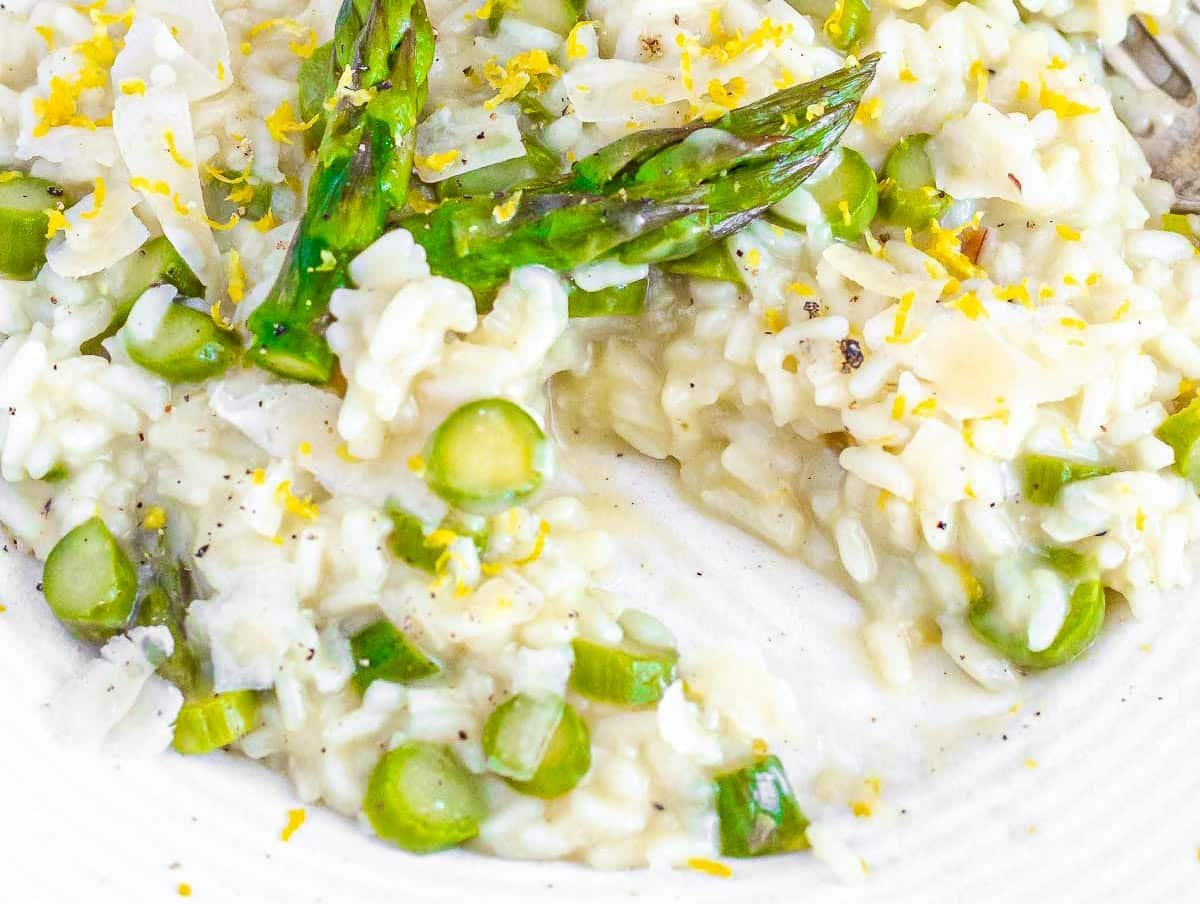
Instructions
1. Cook the asparagus
Trim the woody ends of the asparagus stalks with a sharp knife and set them aside for later.
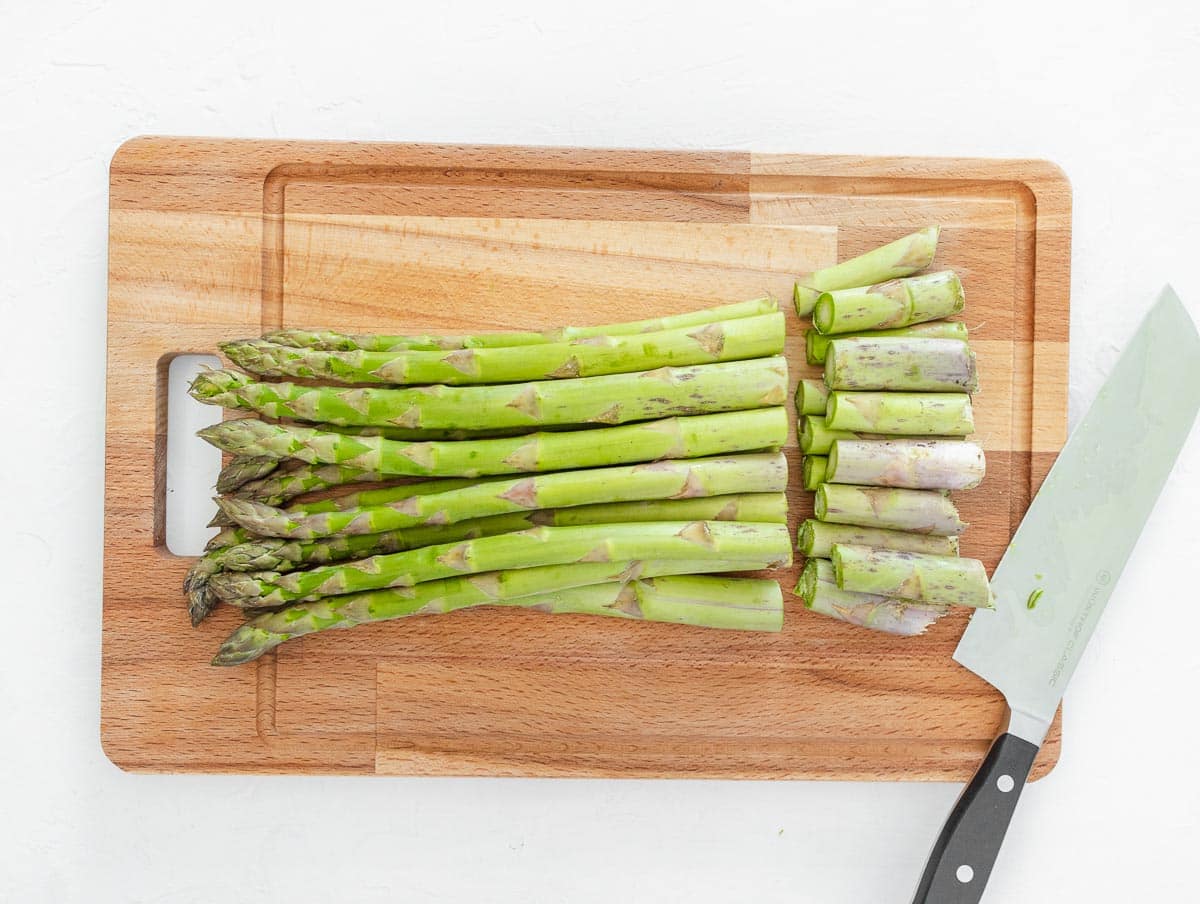
Thinly slice asparagus into disks, but keep the tips of the spears whole.
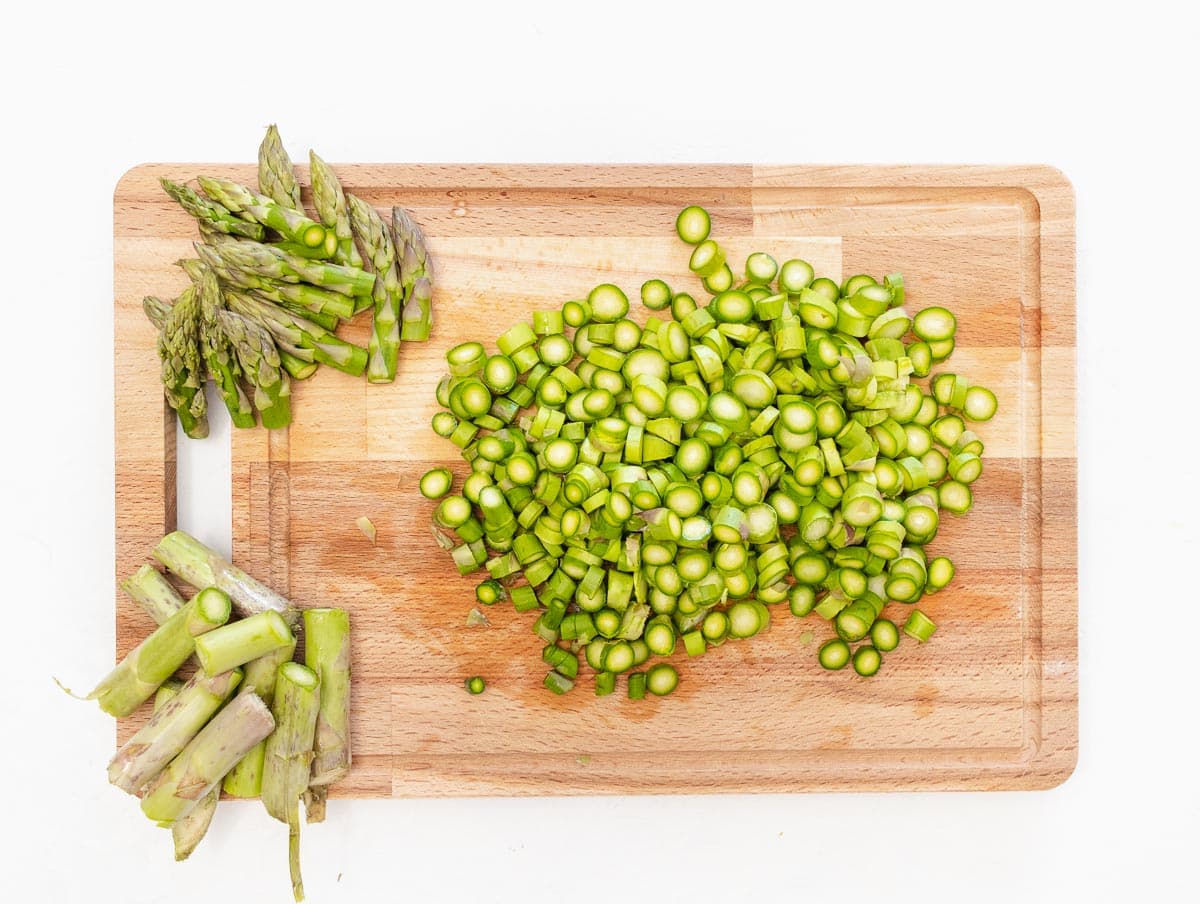
To a non-stick pan, add one tablespoon of olive oil, the asparagus (not the woody ends), a crushed garlic clove, 1/2 teaspoon of salt, and a few twists of pepper.
Sauté the asparagus on medium heat for 5 minutes and set aside.
The asparagus should not be fully cooked at this stage as we finish them later in the risotto.
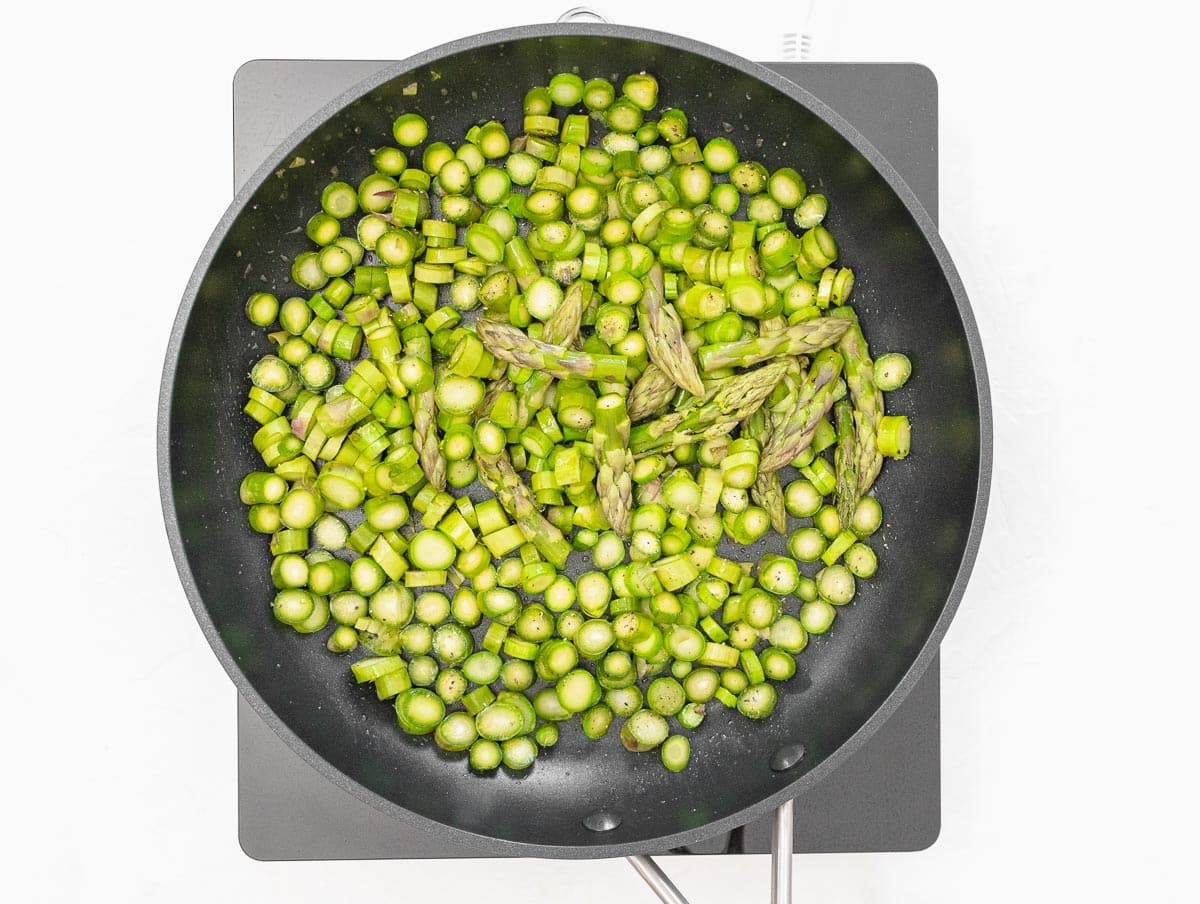
2. Prep the vegetable broth
Add the store-bought vegetable stock and the woody ends of the asparagus to a pot. Bring to a simmer, and keep hot throughout the recipe.
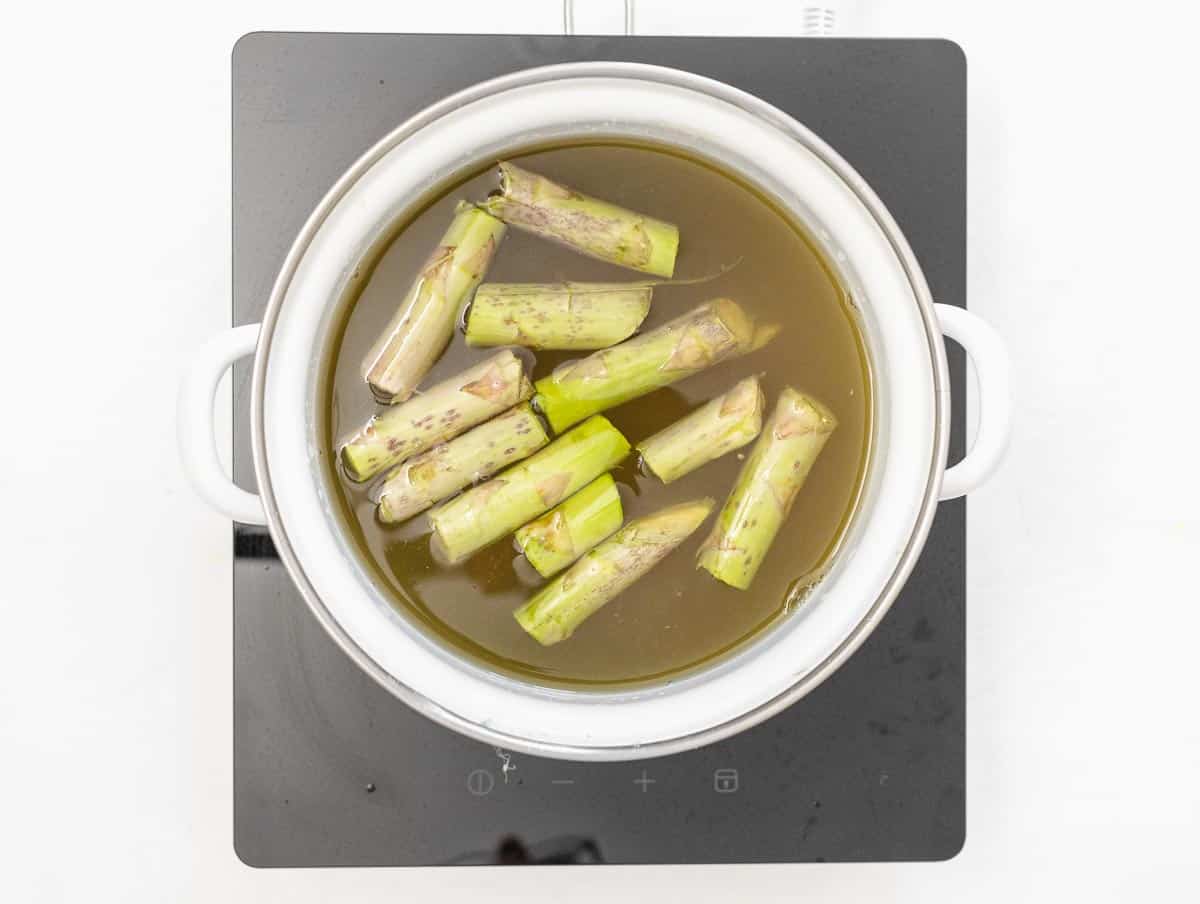
3. Make the risotto
Add one tablespoon of olive oil to a large skillet or a dutch oven.
Set the heat to medium. When the oil is hot, add the finely chopped shallot.
Fry the shallot for 2 minutes until translucent. From now on, keep the heat on medium.
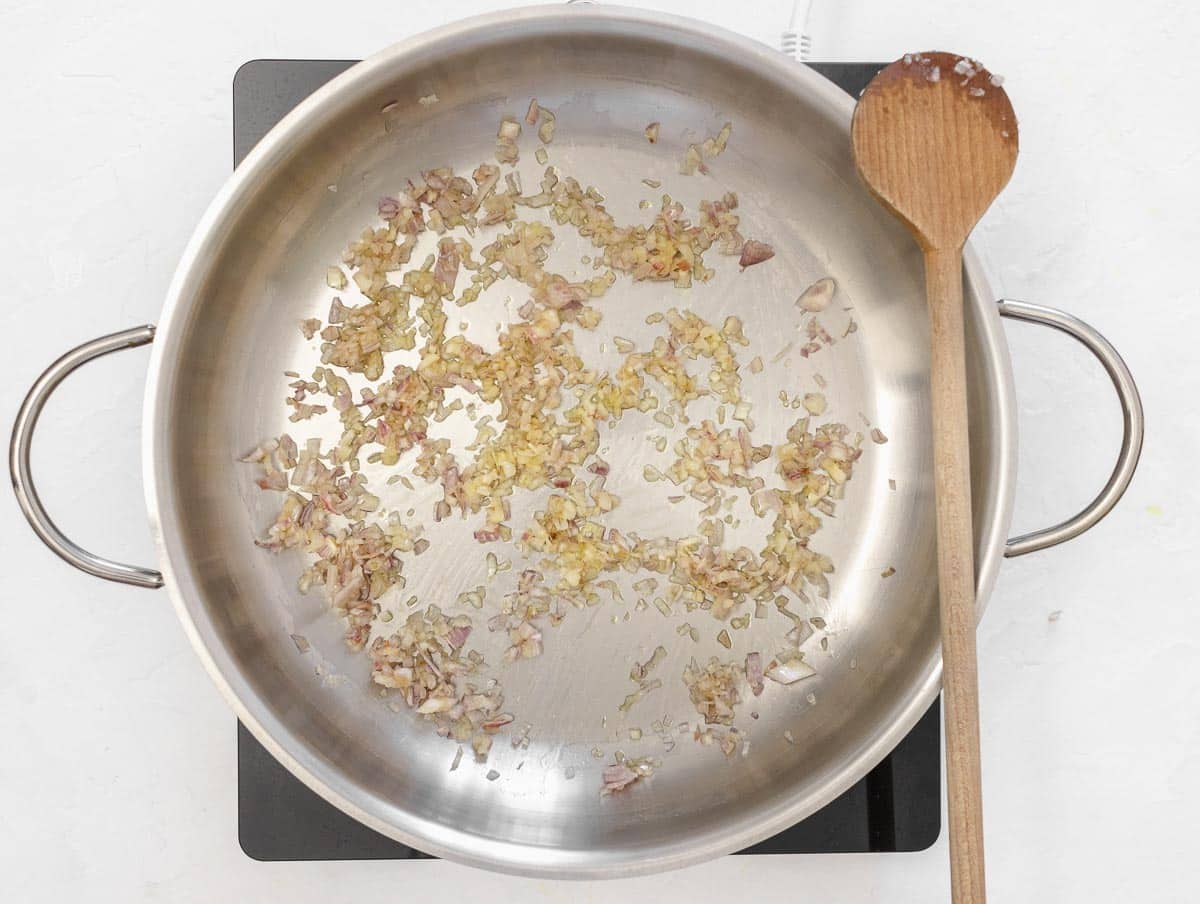
Add the risotto rice to the pan and stir with a wooden spoon. Toast the rice for about 1 minute, stirring continuously. Do NOT rinse the risotto rice before cooking it.
Add the white wine and keep stirring until the wine is fully evaporated.
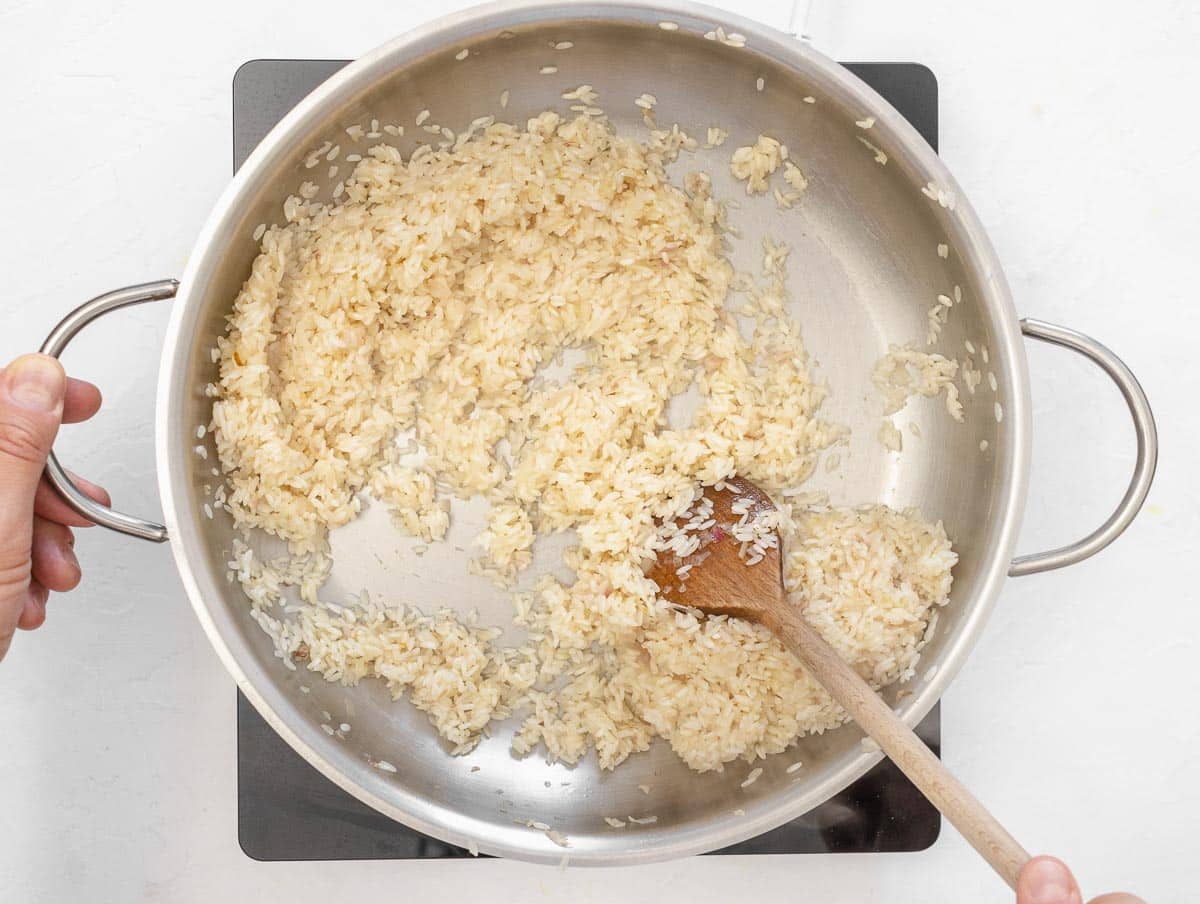
Add 2 ladlefuls of hot vegetable stock. Keep stirring almost continuously.
When the pan starts to dry up, add 2 more ladlefuls of vegetable stock, and keep stirring.
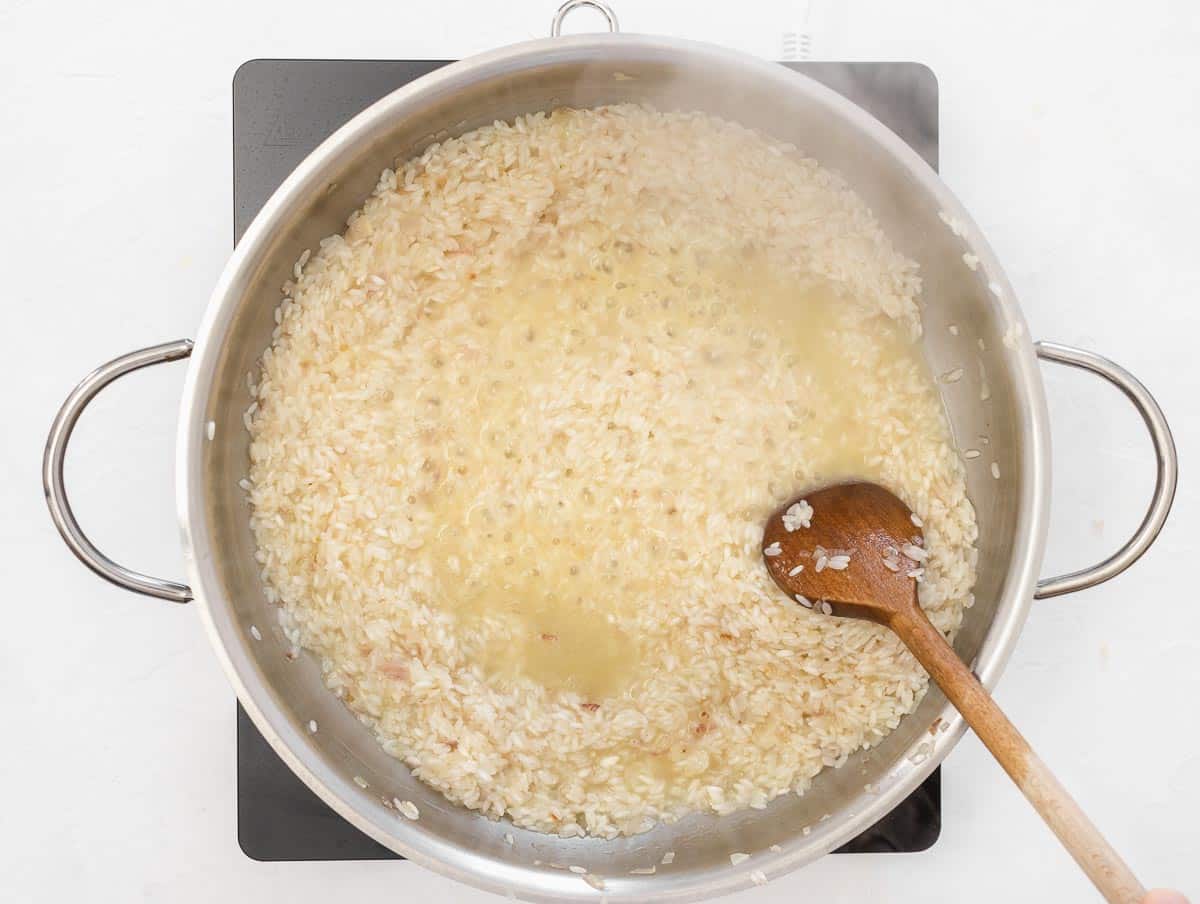
Repeat this for 12 minutes: stir almost continuously, adding two ladlefuls of hot vegetable stock as soon as the pan dries up.
The rice should never stick to the bottom of the pan, and avoid adding too much broth at once.
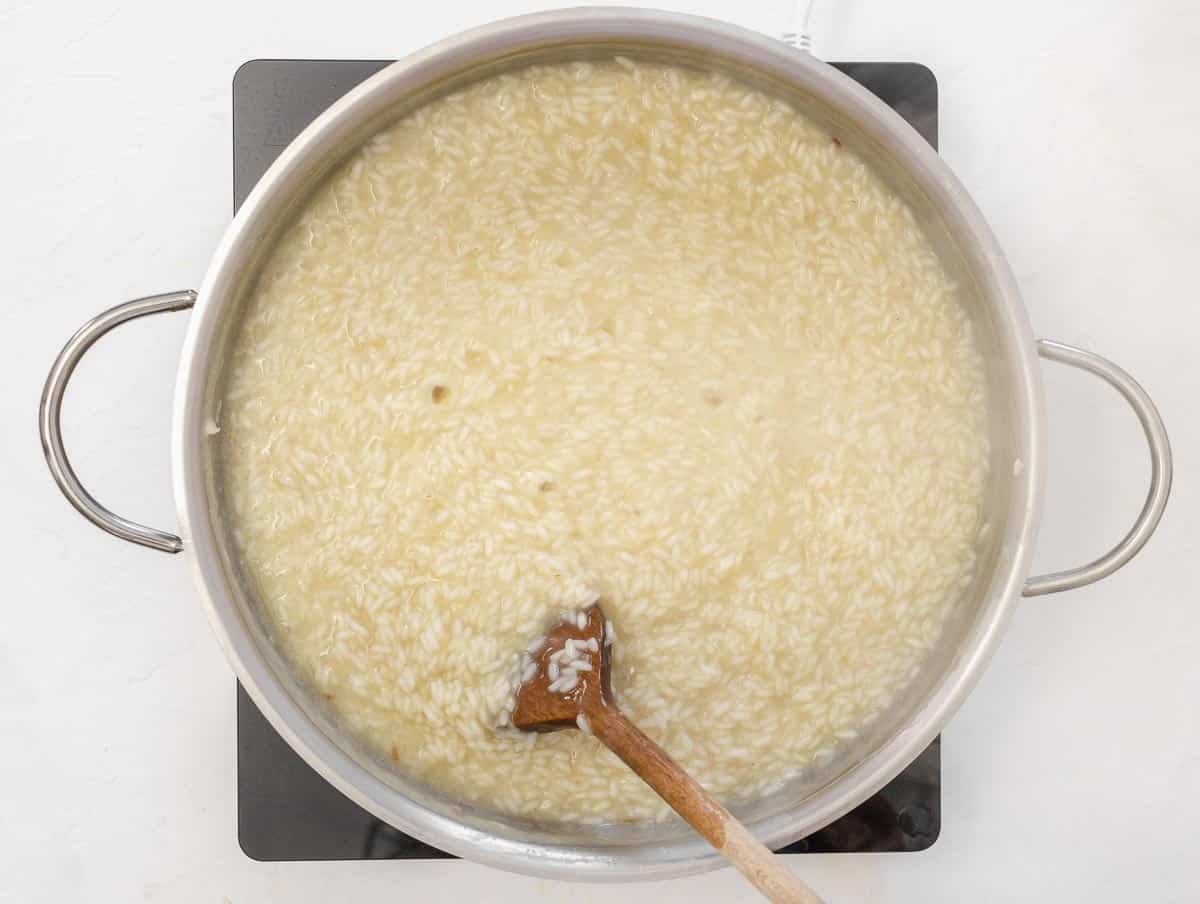
4. Add the asparagus
After 12 minutes, add the asparagus to the rice.
Keep stirring and adding hot vegetable stock until the rice is creamy and al dente – it should take 5 more minutes.
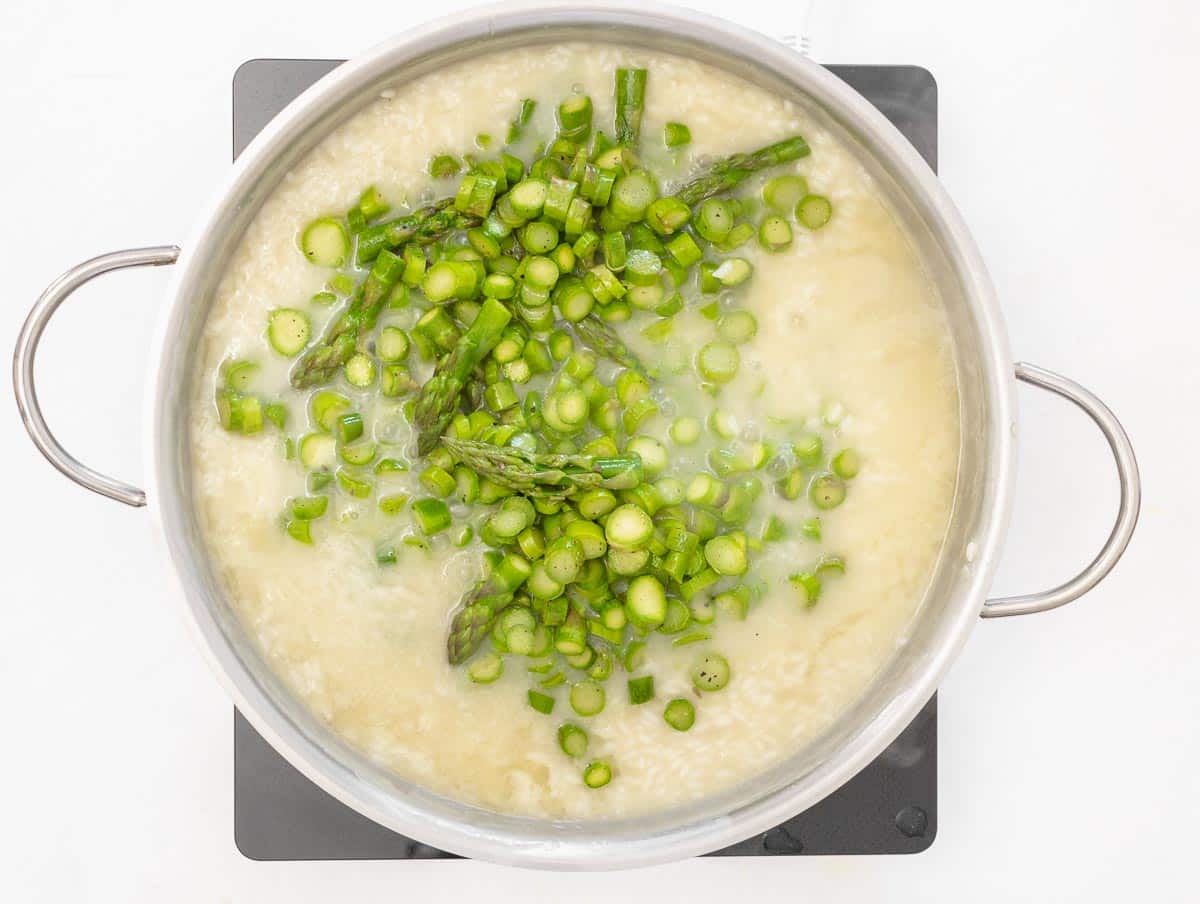
Asparagus risotto should cook between 16 and 18 minutes from when you add the first ladle of broth.
Taste the rice often from the 15-minute mark. When you taste it, you should feel the “heart” of the rice grain between your teeth, and it should feel slightly undercooked.
At this point, you should also adjust for salt if necessary.
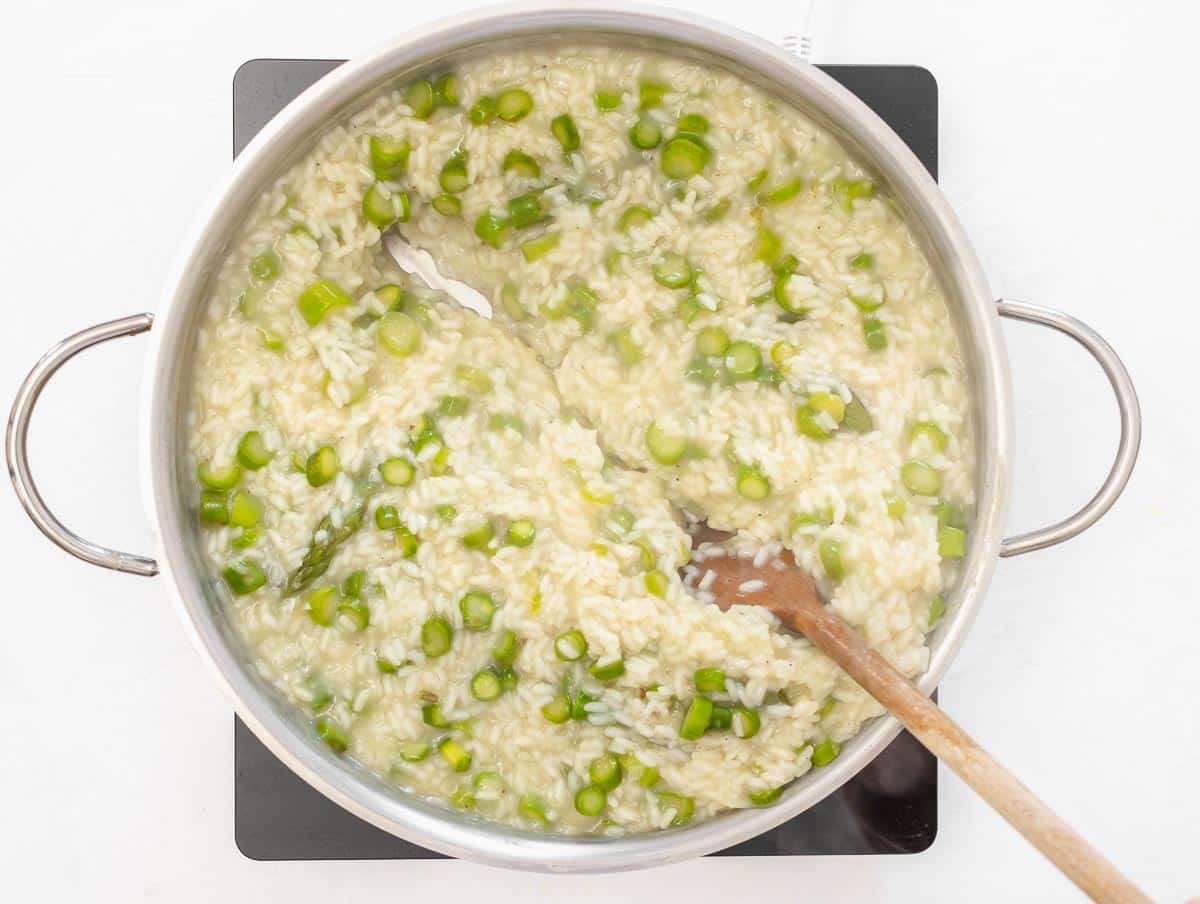
5. Add butter and cheese
When the risotto is al-dente and the last ladleful of broth has been almost completely absorbed, turn the heat off.
Add butter and grated parmesan cheese. Stir gently, off the heat, until butter and cheese are fully melted in the rice.
Now let it sit for 2 minutes, covered with a lid. This final step is crucial for any good risotto, so don’t skip it.
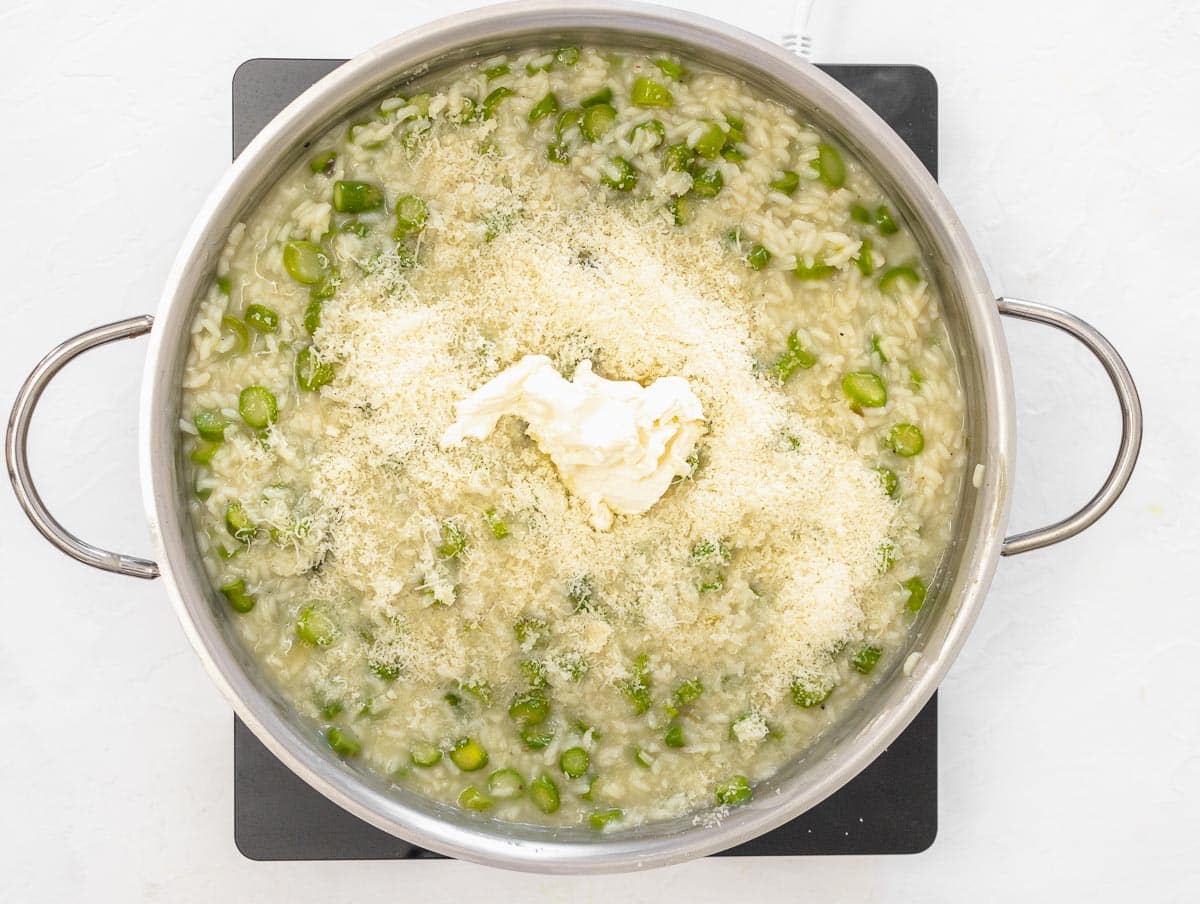
After 2 minutes, stir the risotto one more time, and if too dense, add a bit of vegetable stock, keeping in mind that risotto should not be too runny nor too thick.
It should have a perfectly creamy texture.
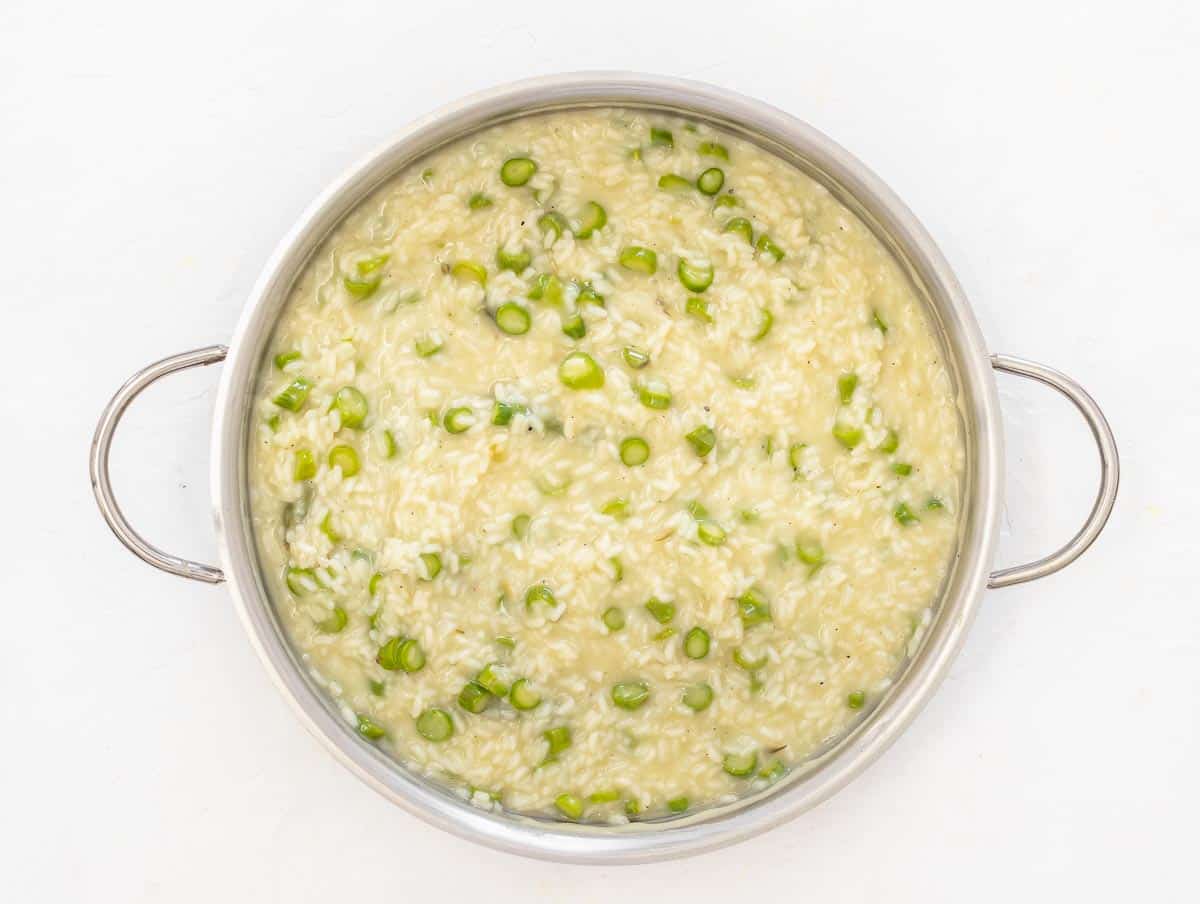
Serve this asparagus risotto recipe on a flat or slightly curved plate (not in a deep dish or bowl).
Optionally, sprinkle with some extra Parmigiano Reggiano and a twist of freshly ground black pepper. Eat with a fork.
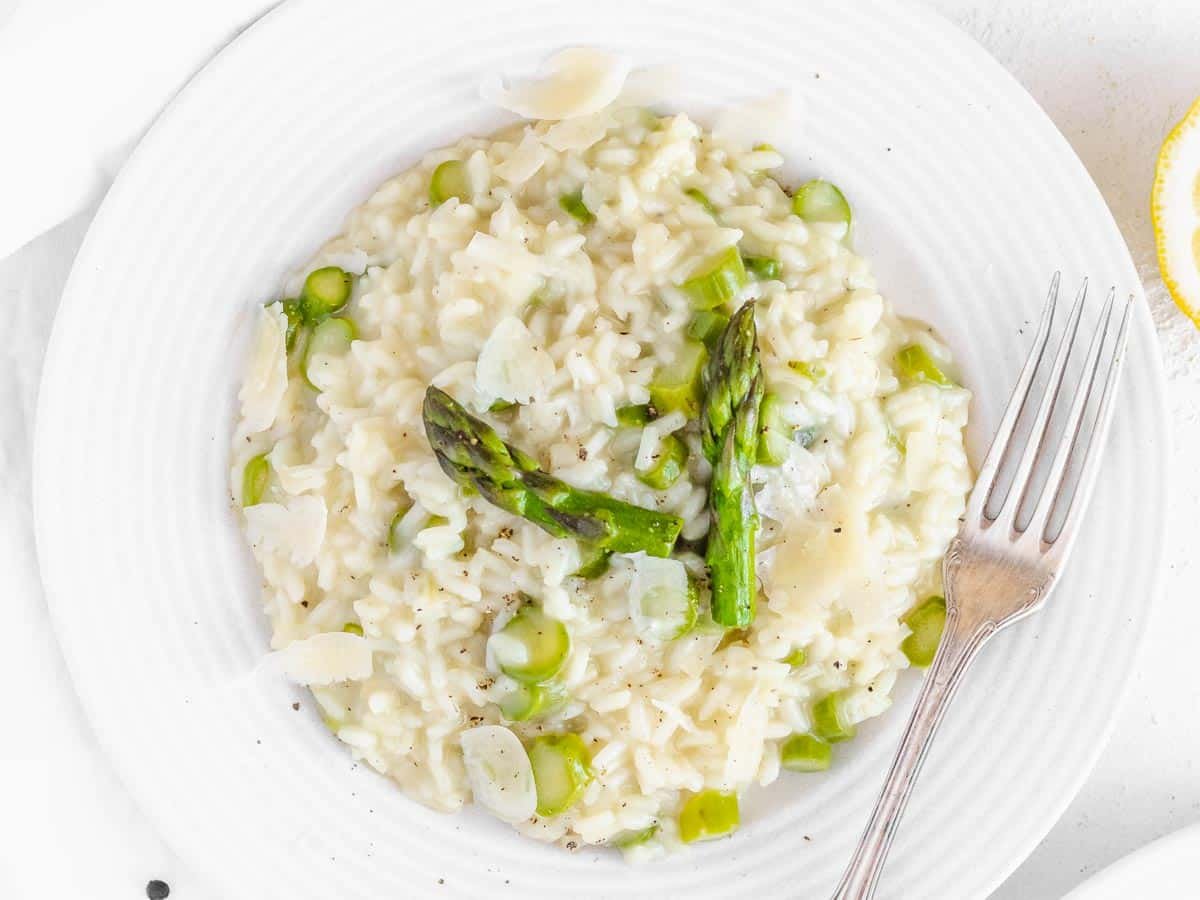
Variations
Lemon Asparagus Risotto
A quick and easy variation is to garnish with the grated zest of an organic lemon on top. Lemon goes well with asparagus, making this asparagus risotto fresh and zesty.
Not everyone likes lemon zest on their risotto, so let people choose if they want to add it. Some prefer to garnish with finely chopped fresh herbs, such as fresh thyme or flat-leaf parsley.
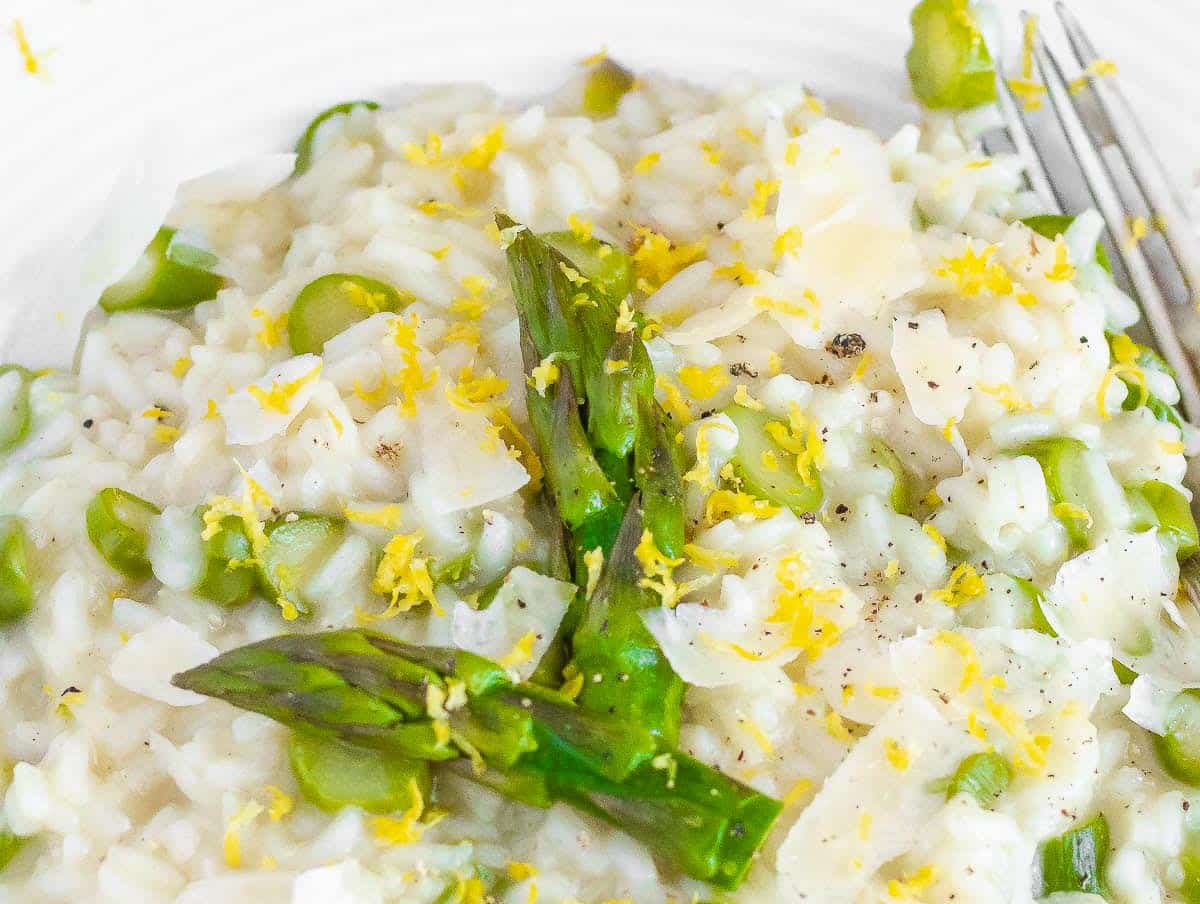
Fancy Asparagus Risotto
If you want to make this dish super fancy, then you could add the following:
- toasted and chopped almonds on top,
- oven-roasted asparagus spears (just the tip of the asparagus),
- thinly sliced raw asparagus (use a vegetable peeler) tossed in a pinch of salt and lemon juice.
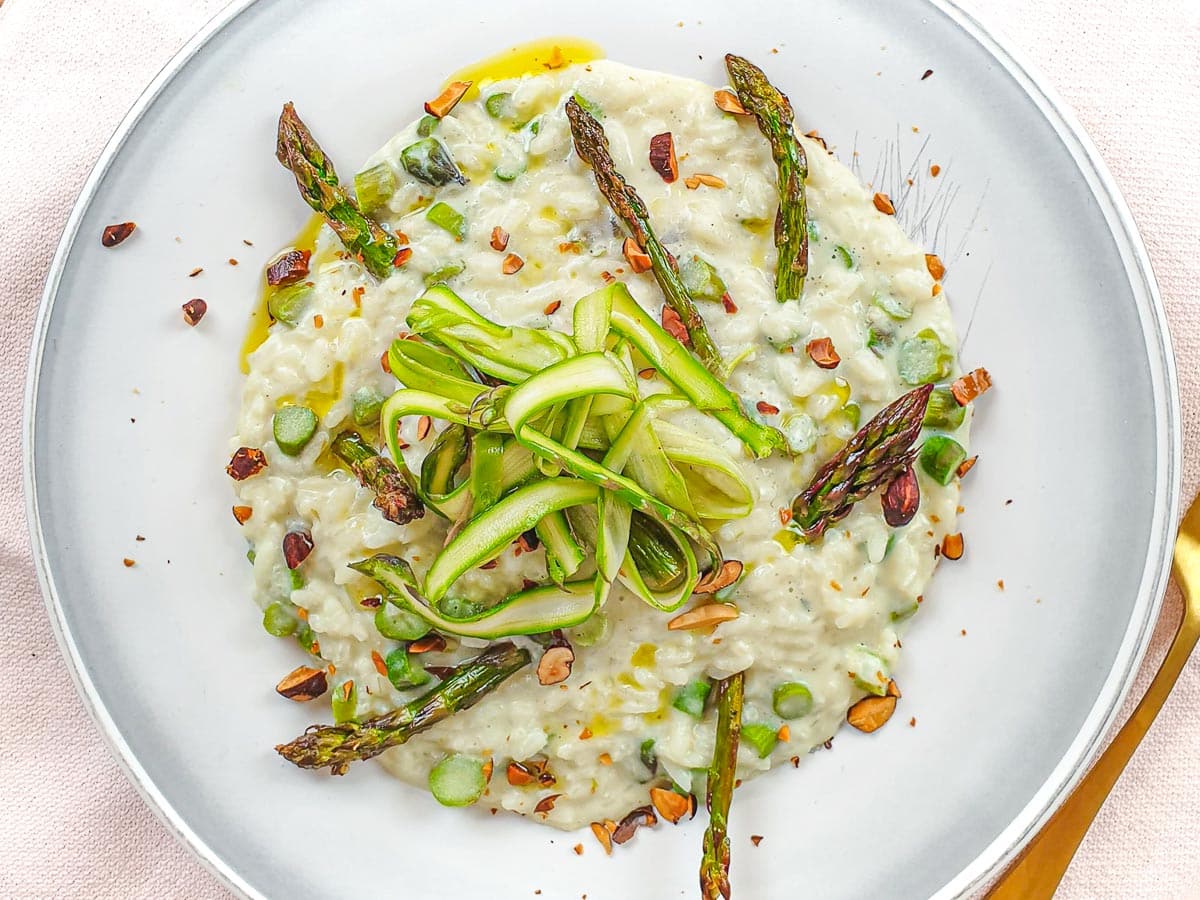
Serving suggestions
This asparagus risotto is a fulfilling meal, and we generally serve it as a main course, either with a light starter before it or with a vegetable side dish. Of course, you can also serve it as a side dish.
Here’s a list of recipes we like to serve with risotto. Some of our favorites are:
- Tomato confit (cherry tomatoes, garlic, oregano, olive oil).
- Caponata (eggplant, olives, capers, tomatoes in sweet and sour sauce).
- Eggplant pizza (eggplants, tomatoes, mozzarella, oregano).
- Socca or farinata (chickpea flour, olive oil, water, salt, black pepper).
- Tomato bruschetta (toasted bread, tomatoes, garlic, olive oil, salt, basil).
Check out our vegetable side dish roundup if you want a delicious side dish. Among our favorite sides are:
- Shaved Brussels sprout salad (cranberries, walnuts, mustard maple dressing).
- Fennel and orange salad (fennel, orange, pinenuts, vinaigrette).
- Panzanella – or Italian bread salad (stale bread, lettuce, tomatoes, cucumber, olive oil).
- Zucchini salad (zucchini, tomatoes, olive oil, pinenuts, lemon juice, salt, pepper).
Tips
What to do with risotto leftovers?
You can transform risotto leftovers into delicious risotto cakes or Italian rice balls and serve them as a main with a simple side salad and with our marinara sauce on the side as a dip.
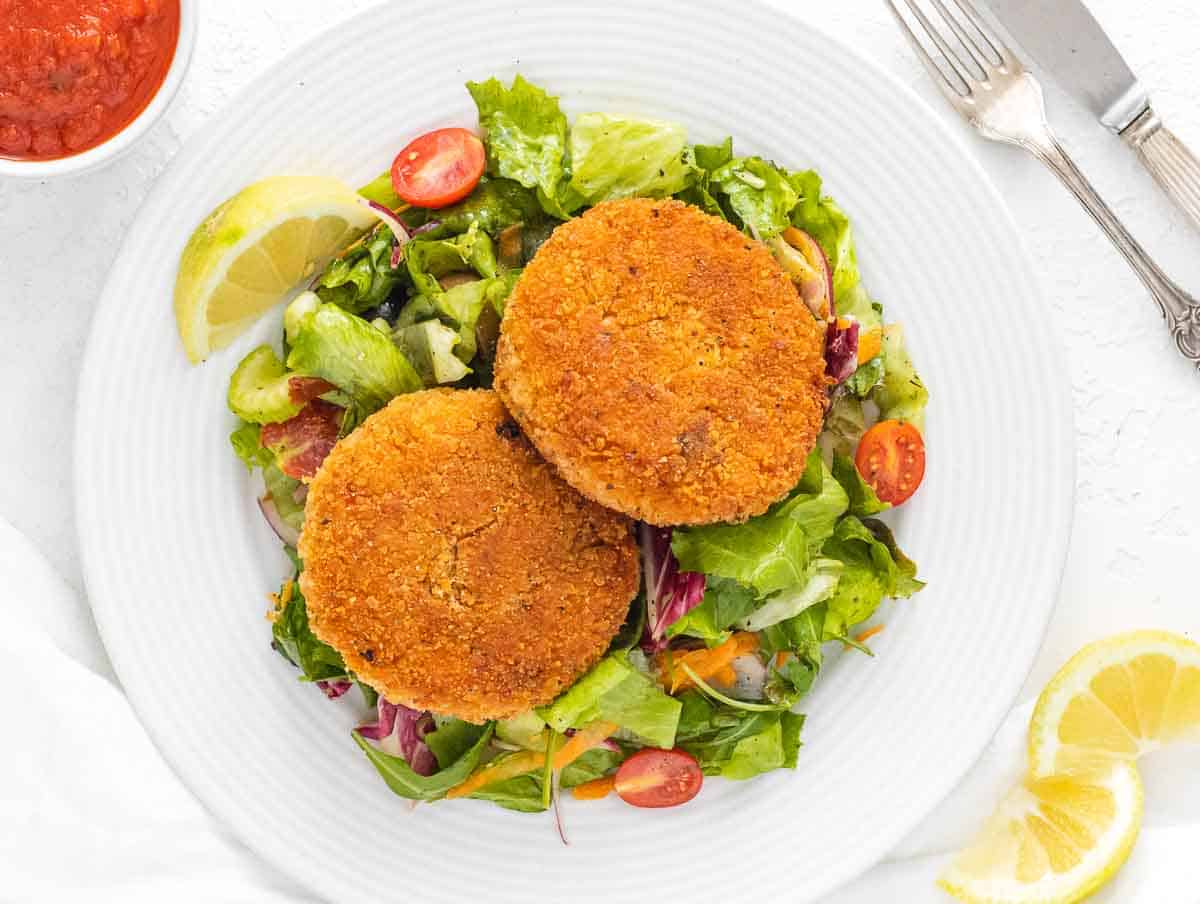
Make Ahead and Storage
Make ahead: asparagus risotto is not a good recipe to make ahead, and it’s best eaten right after making it.
Refrigerator: keep leftovers in an airtight container in the fridge for up to 3 days.
Reheat: warm in the microwave. On the second day, the risotto will be stickier and less creamy, so you might need to add some water or vegetable broth.
Freezing: we do not recommend freezing risotto.
More Risotto Recipes
Can’t get enough of risotto? Try our:
- Mushrooms risotto
- Tomato risotto
- Saffron risotto
- Eggplant risotto
- Zucchini risotto
- Butternut squash risotto
- Vegan risotto
More Asparagus Recipes
If you like asparagus, check out our post on how to cook with asparagus or:
- Air fryer asparagus – one of our favorite ways to eat asparagus.
- Tofu soup with asparagus – incredibly simple and satisfying.
- Steamed asparagus – healthy, tender-crisp, and very juicy.
- Grilled asparagus – smokey, crisp, lemony, and lightly charred.
- Boiled asparagus – probably the easiest way to cook asparagus on the stovetop.
- Baked asparagus – everyone loves roasted asparagus.
- Asparagus frittata (vegan) with chickpea flour.
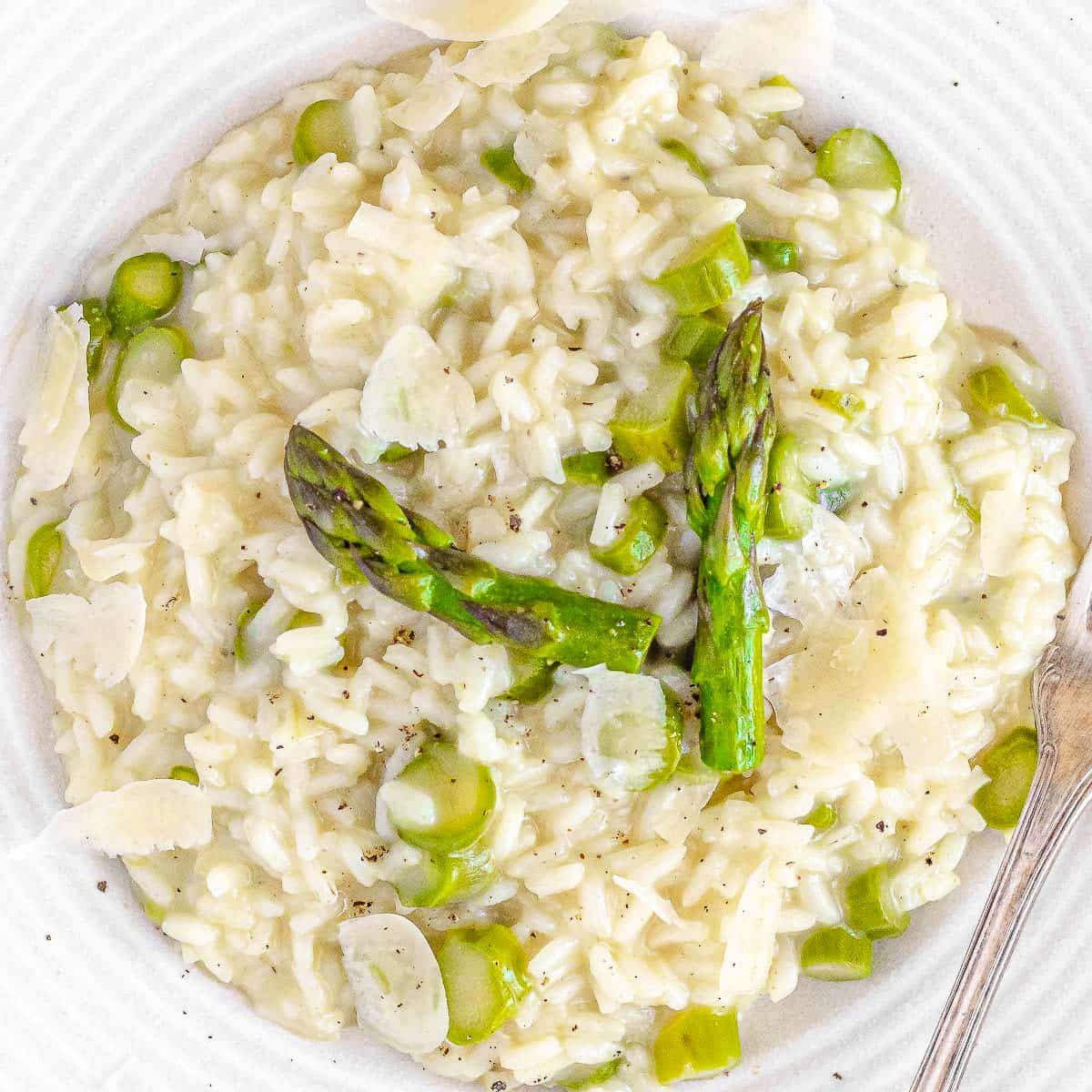
Asparagus Risotto
Ingredients
For the Asparagus
- 1½ pound asparagus
- 1 tablespoon olive oil
- 2 cloves garlic
- ½ teaspoon salt
- 2 twists black pepper
For the Risotto
- 7 – 8 cups vegetable broth
- 1 tablespoon olive oil
- 1 shallot finely chopped
- 1¾ cups risotto rice Arborio variety
- ½ cup dry white wine
- 2 3 – tablespoons butter sub dairy-free butter
- ½ cup parmigiano reggiano sub dairy-free cheese
Instructions
COOK THE ASPARAGUS
- Trim woody ends of asparagus with sharp knife. Set trimmings aside to add to vegetable broth later.
- Thinly slice asparagus into disks, but keep the tips of the spears whole.
- Sauté asparagus with olive oil, crushed garlic, salt, and pepper for 5 minutes. Should be tender but not fully cooked. Set aside.
PREP THE VEGETABLE BROTH
- Add the vegetable stock and the woody ends of the asparagus to a pot. Bring to a simmer, and keep hot.
MAKE THE RISOTTO
- Add 1 tablespoon of olive oil to a large skillet. Set the heat to medium. Add finely chopped shallot and fry for 2 minutes.
- Add risotto rice, and toast for 1 minute, stirring continuously with a wooden spoon.Add the white wine and keep stirring until the wine is fully evaporated.
- When the wine is completely gone, add 2 ladlefuls of hot vegetable broth. Keep stirring continuously. When the pan starts to dry up, add 2 more ladleful of vegetable broth, and keep stirring.Repeat this for 12 minutes, stirring almost continuously and adding 2 ladleful of hot vegetable broth as soon as the pan dries up.
ADD THE ASPARAGUS
- After 12 minutes, add the asparagus to the rice. Keep stirring and adding hot vegetable stock until the rice is cooked al dente. It should take 5 more minutes.
- Risotto should cook between 16 and 18 minutes, from when you add the first ladle of broth. Start tasting the rice often at around the 15-minute mark. When you taste it, you should clearly feel the "heart" of the rice grain between your teeth; it should be al dente.At this point, you should also adjust for salt, if necessary.
ADD BUTTER AND CHEESE
- When the risotto is al-dente, and the last ladle of broth has been almost completely absorbed, turn the heat off. Add butter and grated parmesan cheese.Stir gently, off the heat, until butter and cheese are fully melted in the rice. Now let sit for 2 minutes, covered with a lid.
- After 2 minutes, stir the risotto one more time, and if too dense, add a little more vegetable stock, keeping in mind that risotto should not be too runny nor too thick. It should have a perfectly creamy texture.
- Serve on a plate with a sprinkle of parmesan on top.
Video Recipe
Notes
Nutritional Values
If you liked this recipe, you might also like:
[adthrive-in-post-video-player video-id=”SjstvKwH” upload-date=”2023-02-23T06:38:32.000Z” name=”Asparagus Risotto.mov” description=”Asparagus risotto is a creamy, bright, and delicious recipe for a special dinner with your loved ones.
Making risotto is easy, and with our step-by-step pictures and video, your risotto will be a guaranteed success on your first try.” player-type=”default” override-embed=”default”]
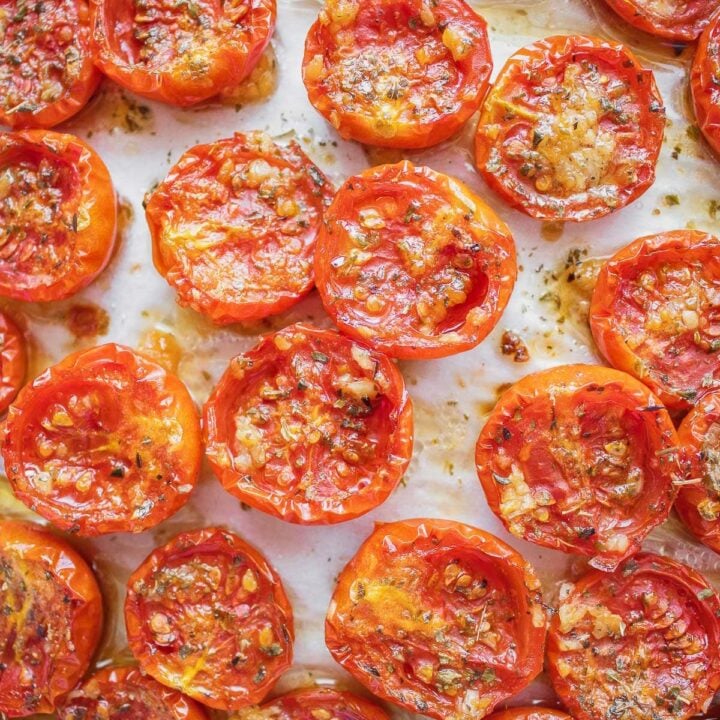
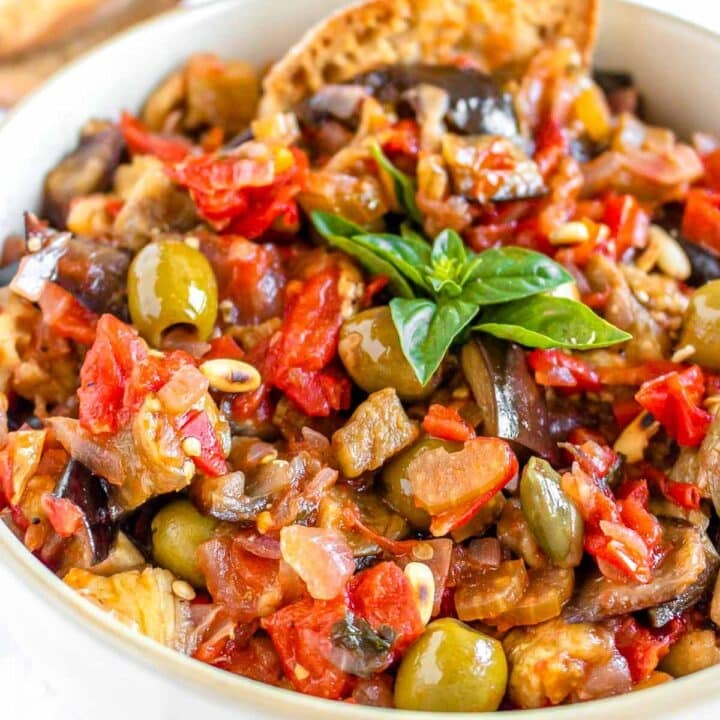
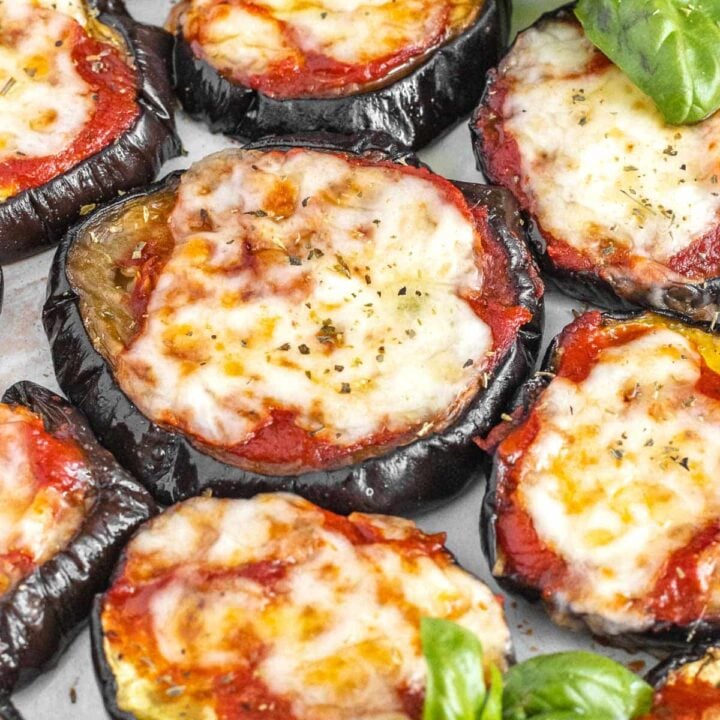

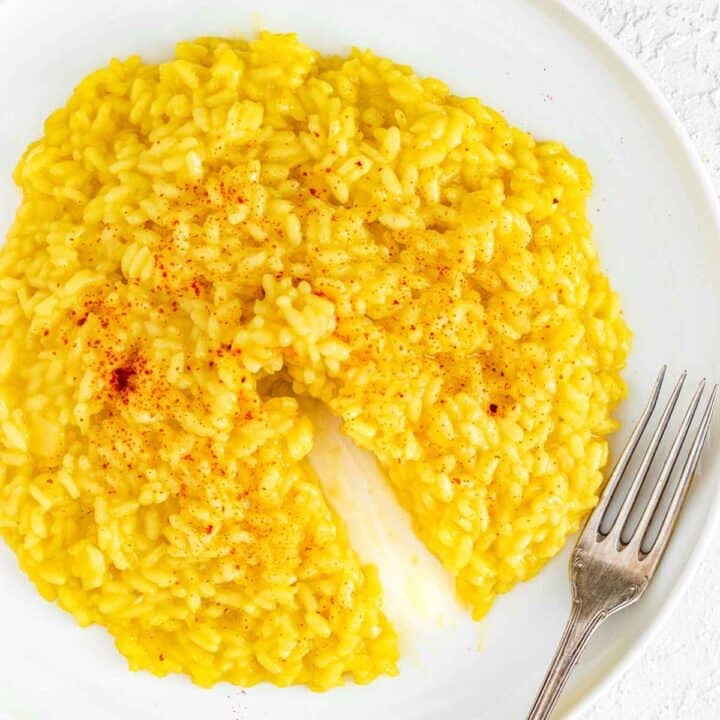
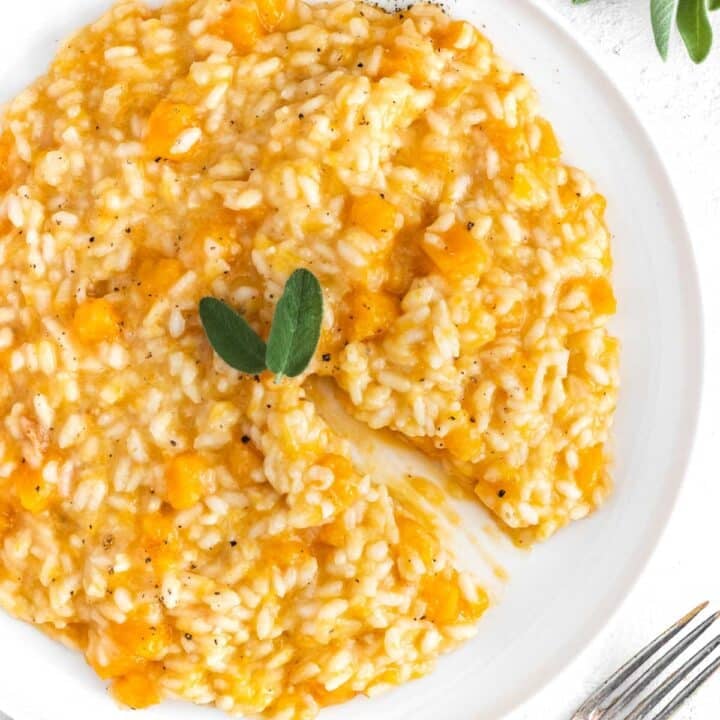
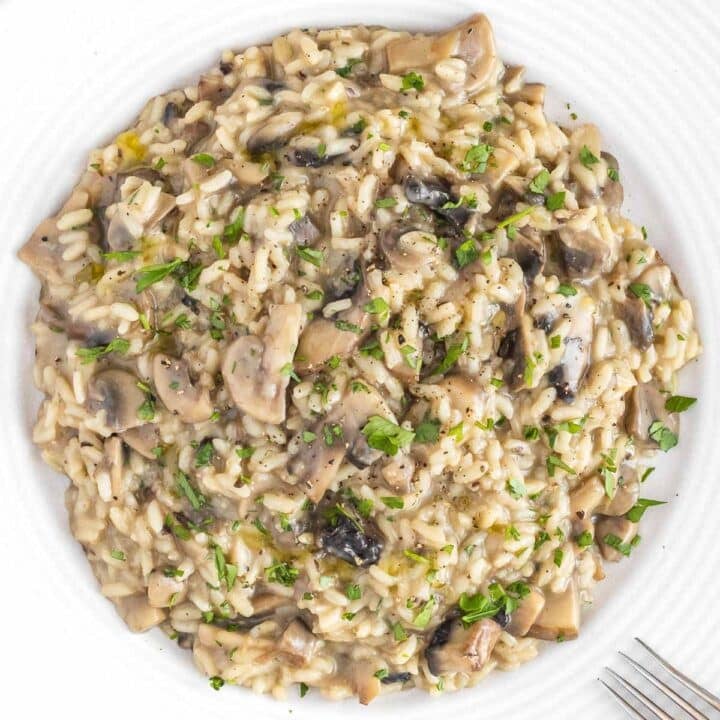
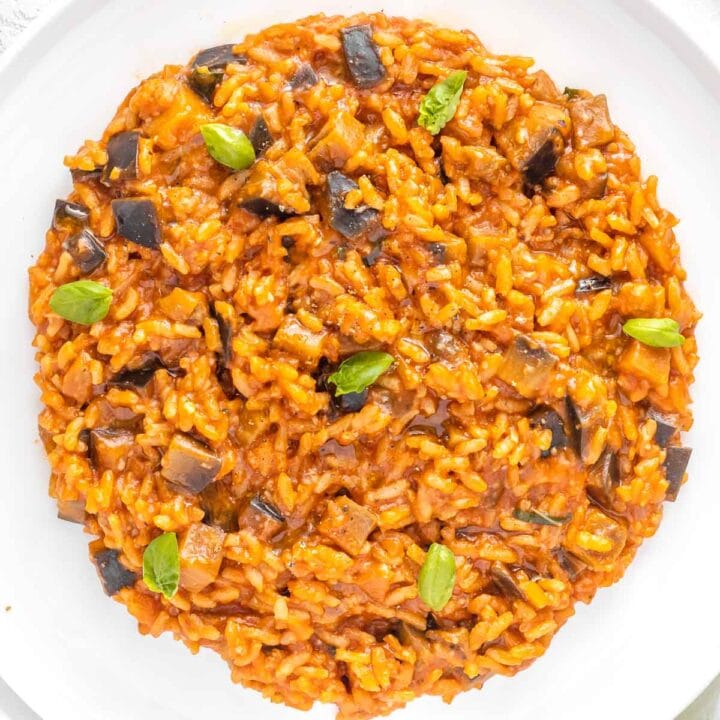
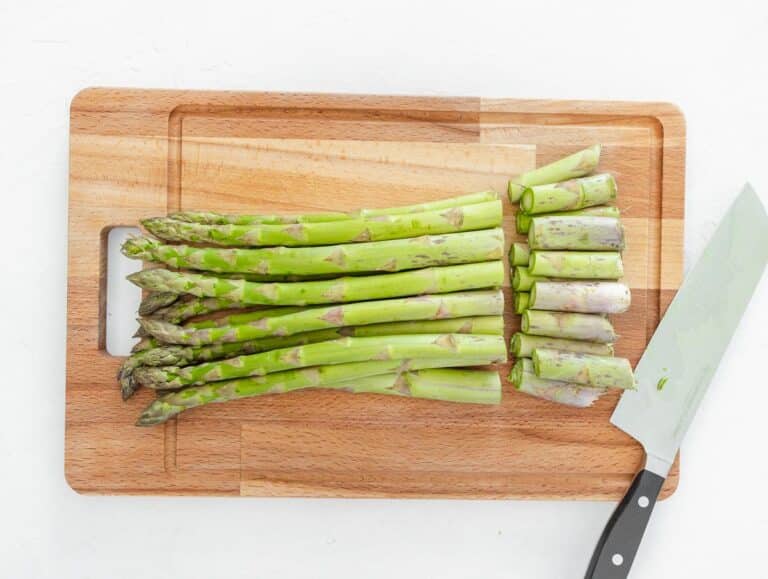
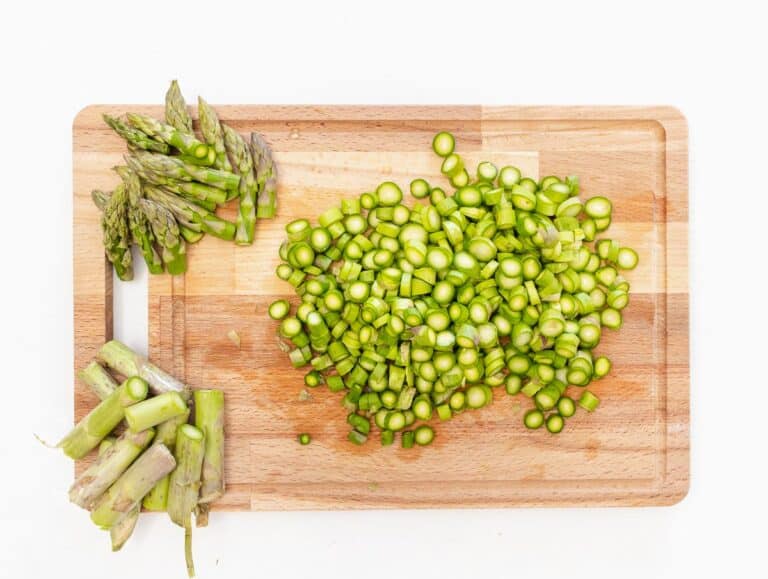
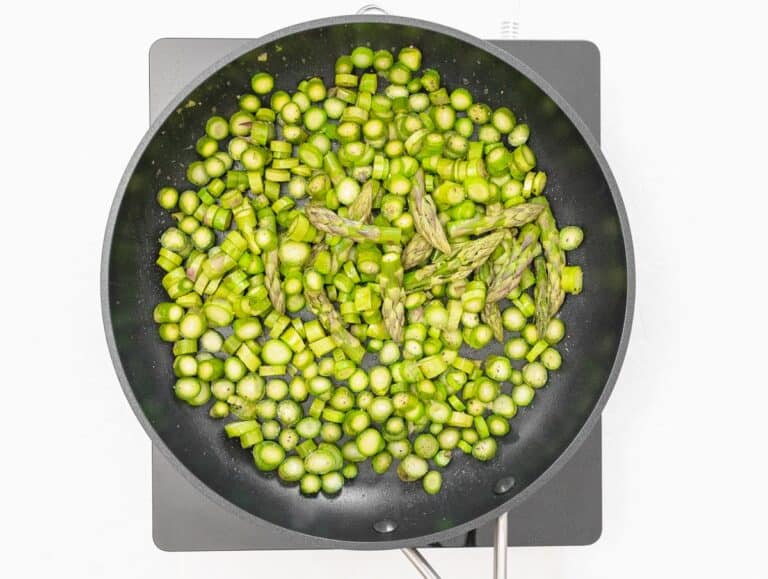
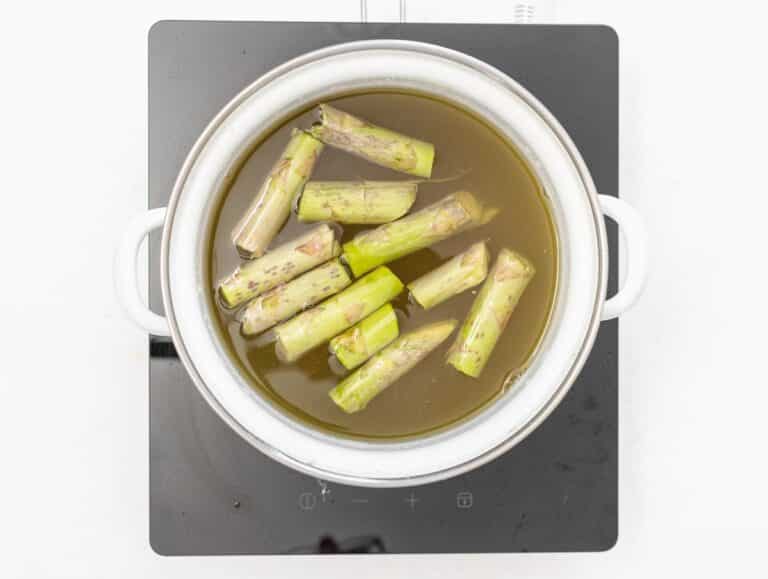
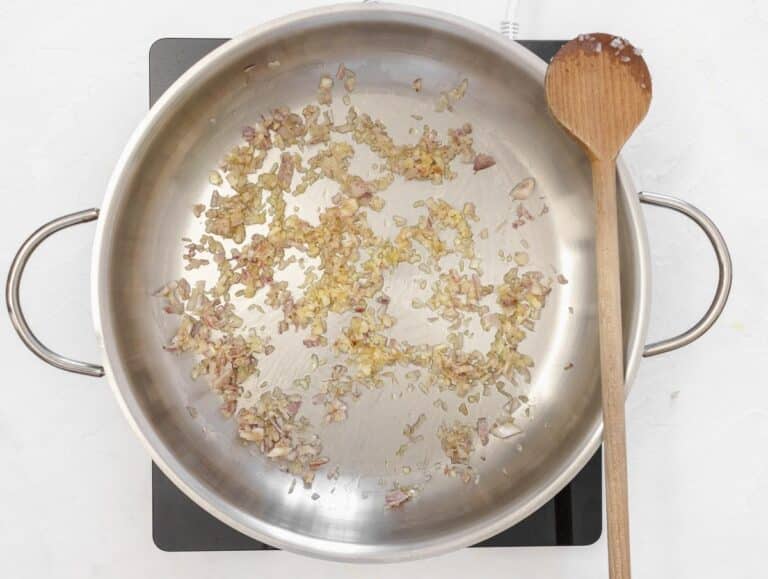
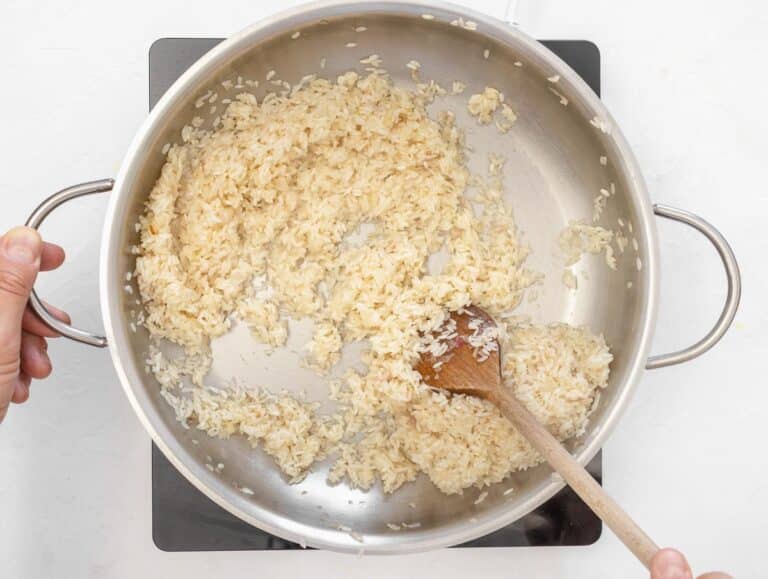
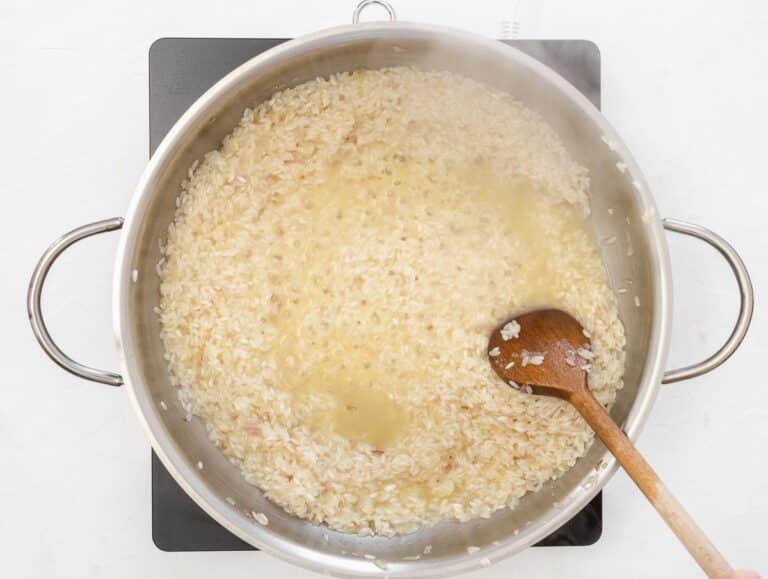
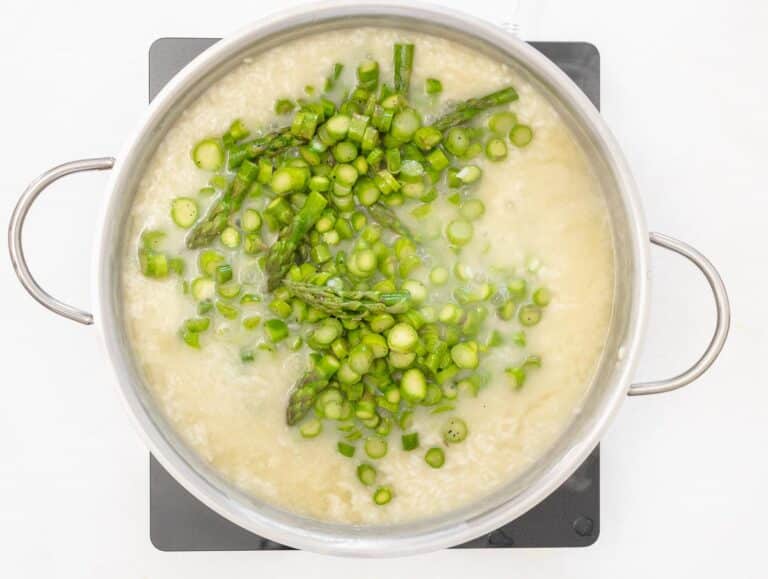
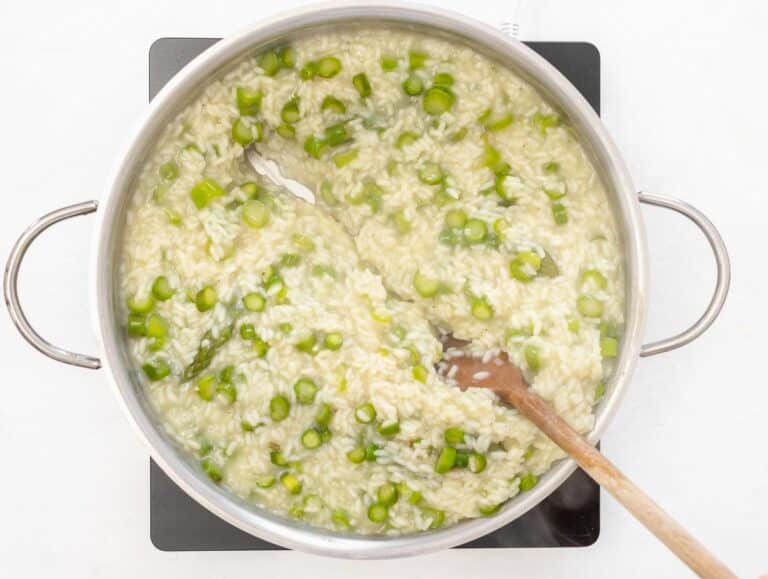
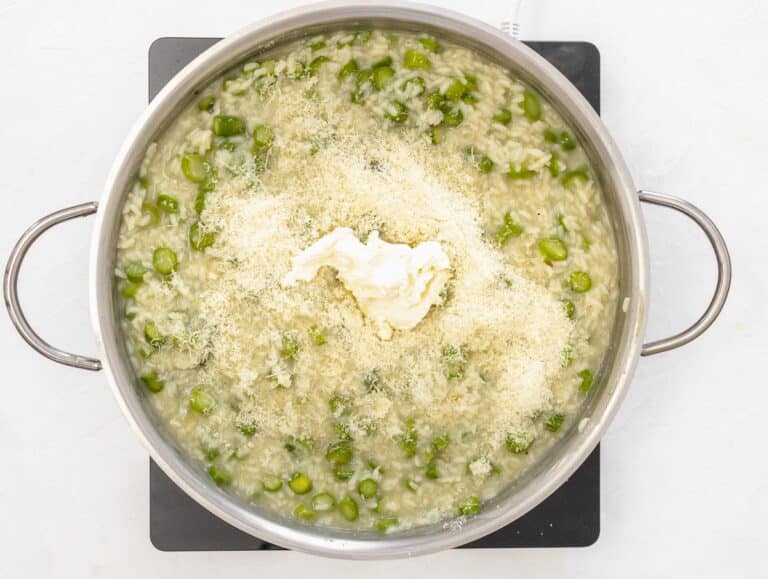
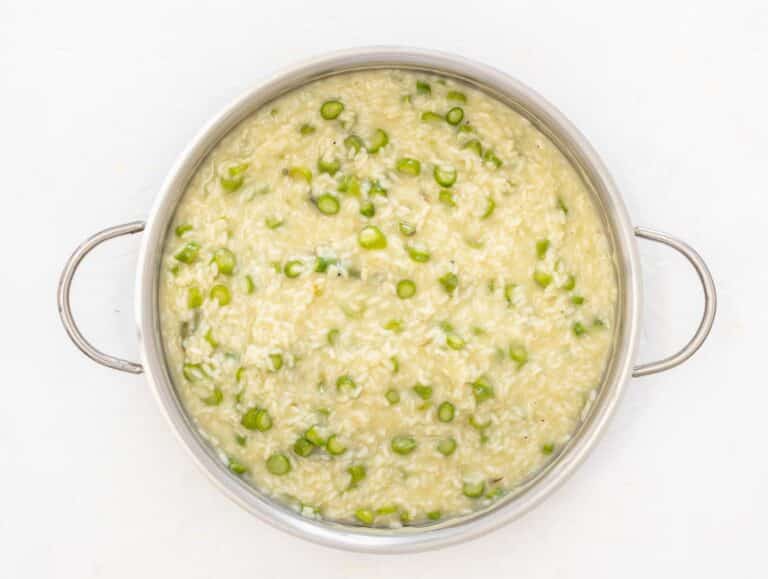
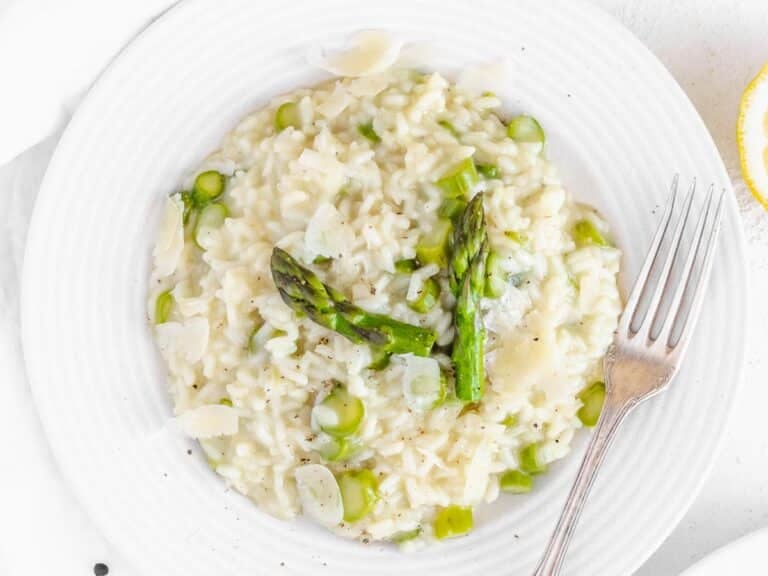
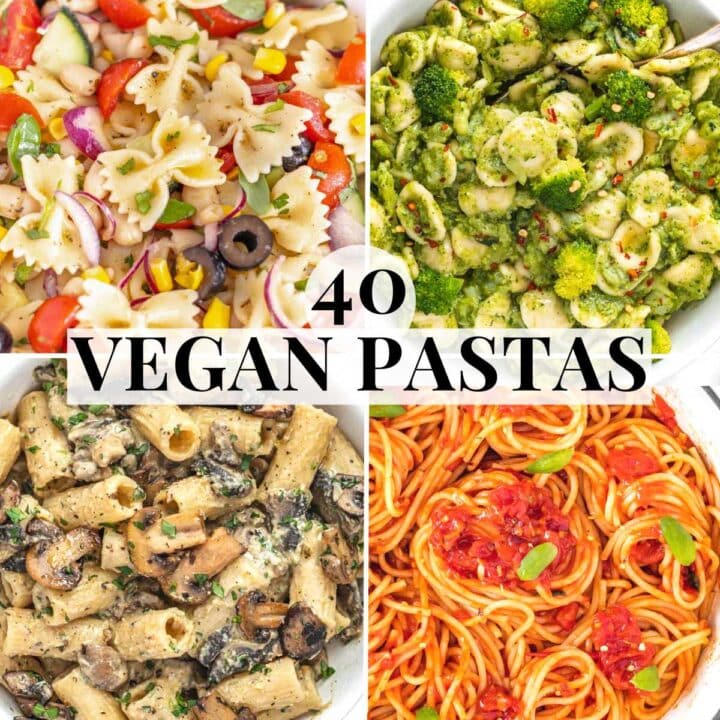
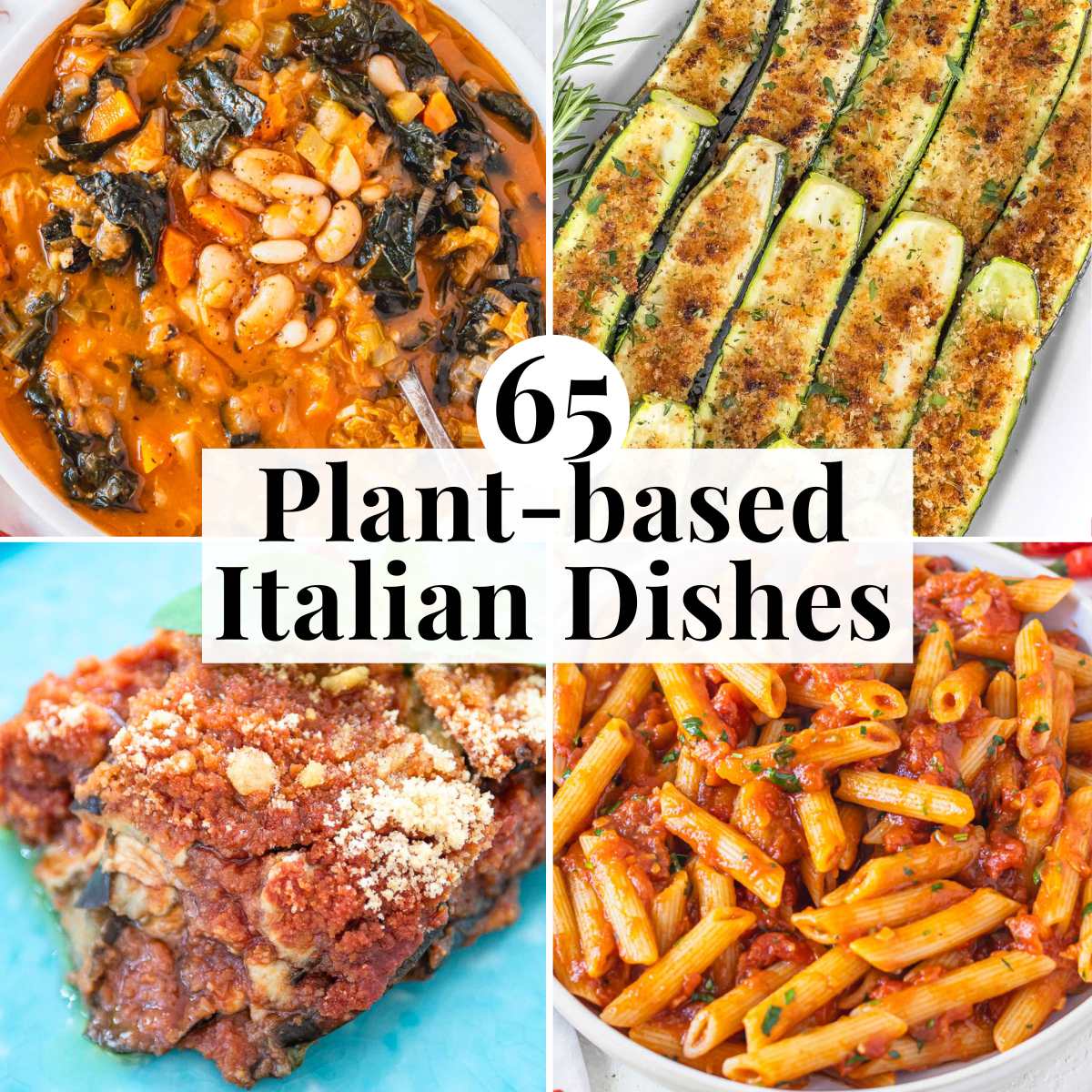
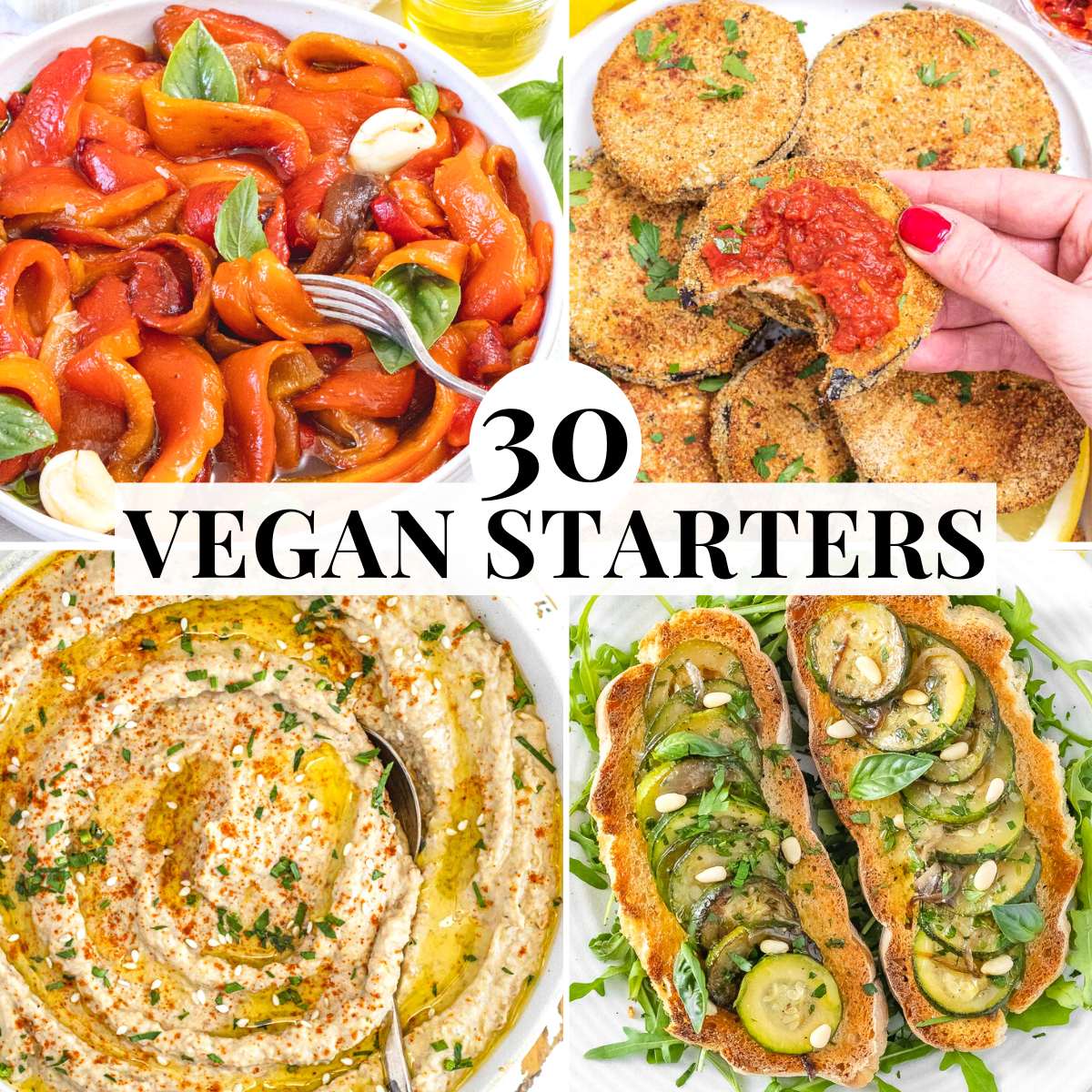


Absolutamente delicioso!